These are the ones that got away. As said before, a collection should in my opinion be dynamic, and any collector or trader will relate to exchanging items for something better. Or totally different.
You buy the cheap version. Or even the copy, and when the time is ripe and the funds are available, you trade up.
Or you just got bitten by the eBay bug and clicked on something cool, but what was the point?
And you might even end up totally disappointed in something you have wanted for a long time, and finally have acquired.
There is a large market out there, and I still haven’t experienced great financial losses. Neither by overpaying in the first place, or getting damaged or faulty goods. I am also fairly certain all these sold pieces have made their new owners pleased.
So they, too, deserve a place in here, after years or maybe just months.
The first
Nameless acoustic guitar (ca 1967-ca 1974). Photo not available.
Basic acoustic with flat fretboard and slot head, steel strung.
Unknown brand. My grandmother gave me my first guitar in the mid sixties. Extremely high setup, and got more played with (as in play with toys) than played. But eventually I mastered the C major scale and a couple of chords. It took some time before I came up with the brilliant idea of putting nylon strings on it.
Somehow it got lost after moving to Namsos; by then there were more serious contenders.
Eko Escort(?) (1972-1973). Photo not available.
Three-quarter deep jazz guitar, with a Lucky Seven pickup unit attached. This looked more traditional than Eko’s accordion-inspired switches and mother of pearl on their solidbodies. I have tried to ascertain which model I had, but at that time there were Stratocasters and other guitars; this was an Other. It could have been an Escort; it looked like this photo I found on the web.
Giving up my ambitions of becoming a drummer (in a block of flats) I bought the second-hand Eko at Imerslund for 200 kroner (about £17). Plugged into the headphones socket of the family hifi I could blast out (I’m not using the word play) Wild Thing and the riff from Sunshine of Your Love straight across the park from our fifth floor apartment.
I started learning from Odd Arne Jacobsen in 1973. The Eko was OK for practising chord shapes, but I was ready for something better… With my new Ibanez and Dynacord amp replacing the Eko and Radionette, it was eventually sold.
Epiphone Emperor II
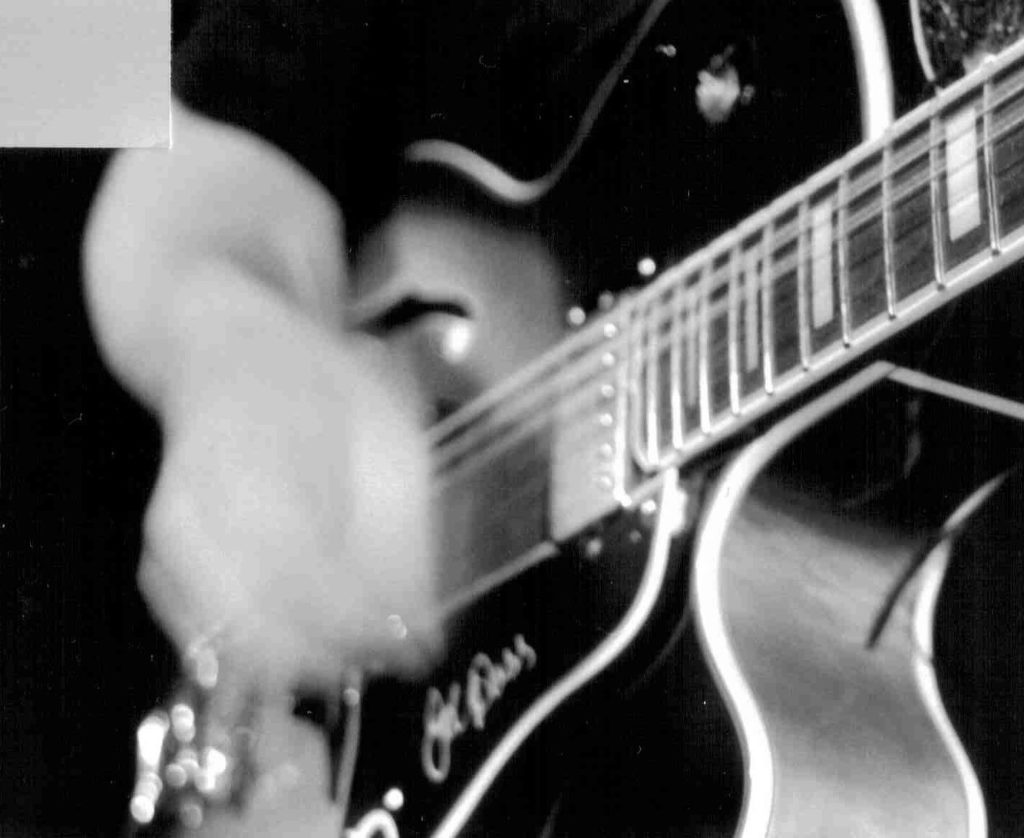
Epiphone Emperor II Joe Pass 1995 (1996-2002)
Maple hollowbody with venetian cutaway, maple set neck with bound fretboard, two humbuckers with standard two-volume, two-tone controls.
Epi Stathoupolos was probably Gibson’s biggest competitor (and actually predated Gibson) with quality jazz and semi-hollow guitars. Gibson acquired Epiphone (they believed they bought the double bass manufacturing equipment, but found they had the whole guitar-making company on their hands). As well as continuing making Sheratons, Casinos and others, Epiphone became the budget manufacturer of the classic Gibsons. The Emperor had been top model for some time, and this is the Emperor II Joe Pass signature model.
In 1996 I had the Ibanez classical, some weird ethnic instruments, and a drum kit. Why not expand? I missed my Ibanez solidbody, but at this moment I wanted a steel-strung guitar that would be heard with or without an amplifier. Steve Howe of Yes had taken Jimi’s place as my favourite guitarist, and I liked the idea of crossing musical borders by taking the Gibson ES-175D, typically a jazz guitar, into progressive rock. I had seen Joe Pass play with Oscar Peterson and NHØP in Konserthuset, Oslo in 1979, so something with his name on it shouldn’t be wrong.
Morten at Strandberg ordered this for me. He offered to let me borrow a Peavey Bravo tube amp to be able to test it properly, and I kept both.
I played it enthusiastically for some time, and it worked well on (42). The mellow Joe Pass provided some nice contrasts to the rockier Stratocaster, playing clean leads on Four Walls, Fire på seks, Du kan gjøre… as well as unleashing the feedback at the start of Warmer Welcome. And, of course, the long solo at the end. Still there was something that didn’t really click. Performing Warmer Welcome live, I switched to the Ibanez 2351M I just had been able to buy back.
I did not feel it gave back the energy I put into it, as opposed to the newly acquired Les Paul Special. Maybe I should have experimented more with setup and string gauges, but eventually I traded it for a Jay Turser 335-copy. And later still, there were proper Gibson hollowbodies and semis incoming.

Yamaha AEX500
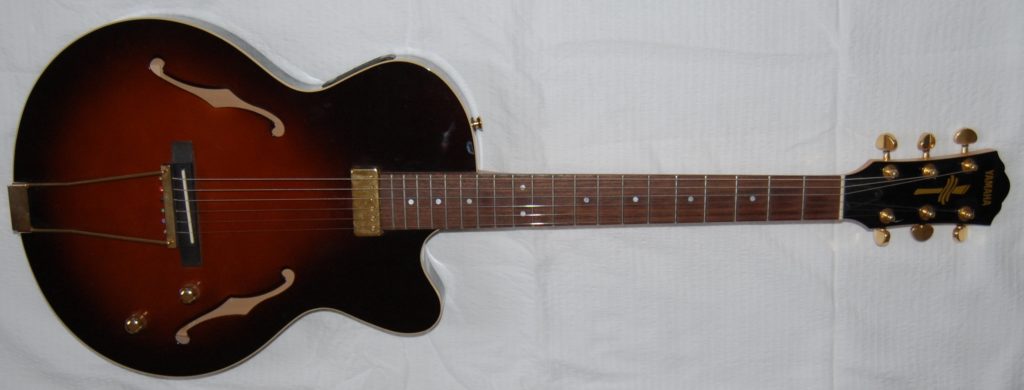
Yamaha AEX500 (2001-2016)
Electro-acoustic singlecut thinline, mini humbucker (neck) and piezo bridge, bolt-on neck, piezo preamp, master volume and blend
Yamaha was the first Japanese manufacturer to be taken seriously in the West. Known for excellent quality and a great selection of models, at a reasonable price. Now even the Japanese have gone into manufacturing abroad, so a number of instruments, including this, have been made in Korea.
I wanted an amplified acoustic, and the thinline body appealed to me. I tried a Godin (too expensive) and a Stratacoustic (OK sound, but plastic??) before I found this. The piezo/humbucker combination could make it a good allrounder, especially for performing or recording on the move. I played it at a backyard party at my workplace, and brought it up north to be recorded by the Tascam. It has also served with the theatre.
I have never come to terms with the intonation. I like the feel of it, and it sounds good, but there is a choice between being in tune in the ground position or up the neck, and I do not like to feel restrained. Thinner strings helped, and I considered it for the 2009 Session, but decided on two guitars instead.
I traded it one to one for a Fender Sonoran, which stayed with me for mere months before being sold again.

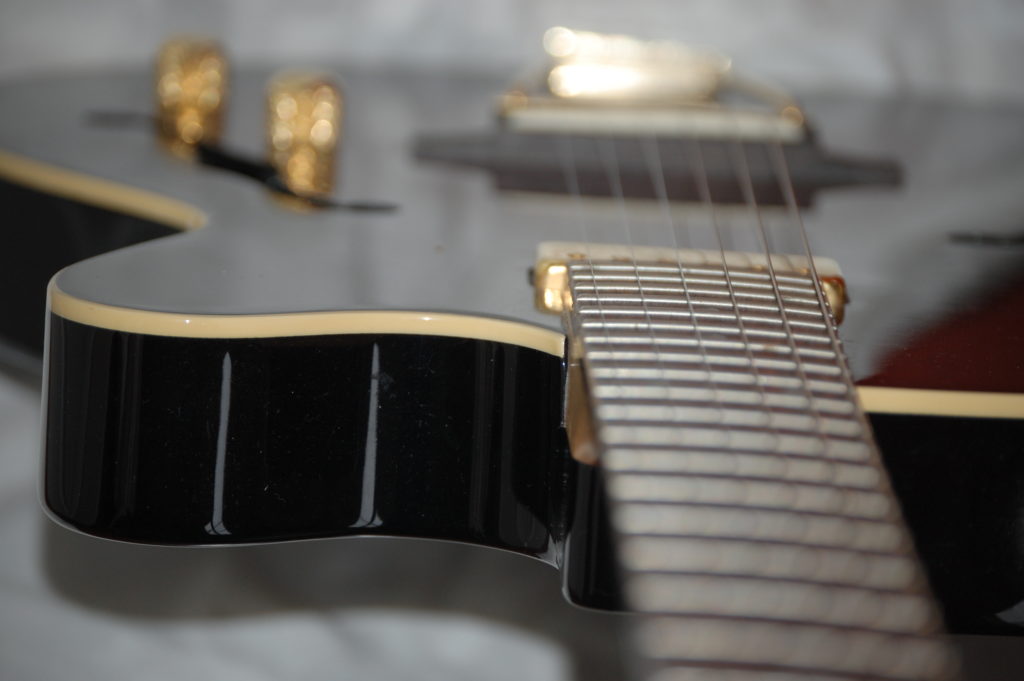
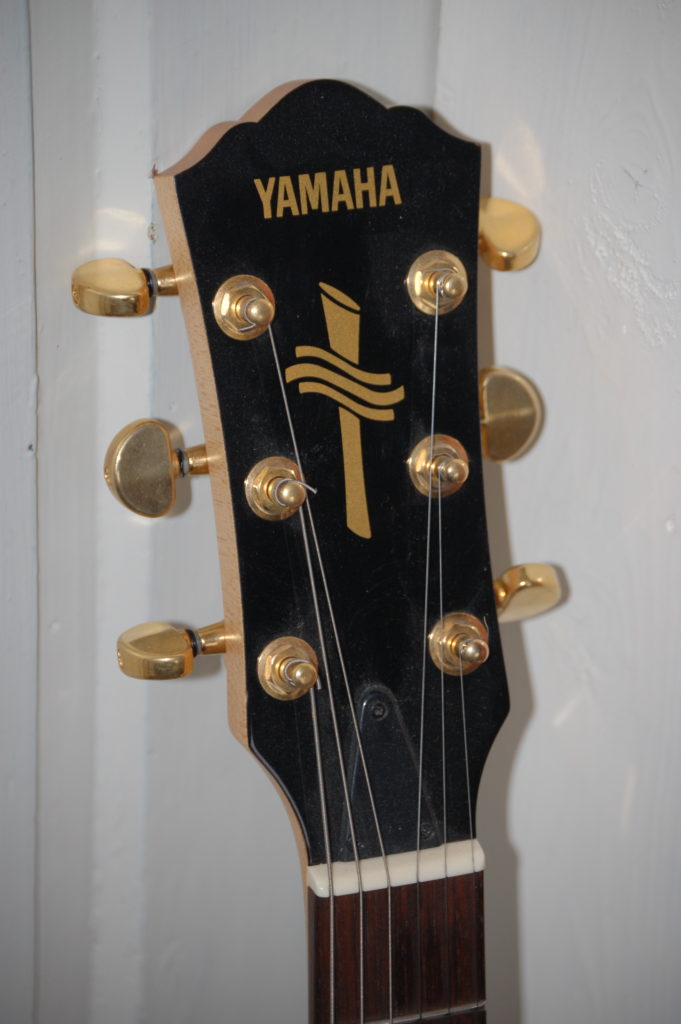
Blade Durango Magnum
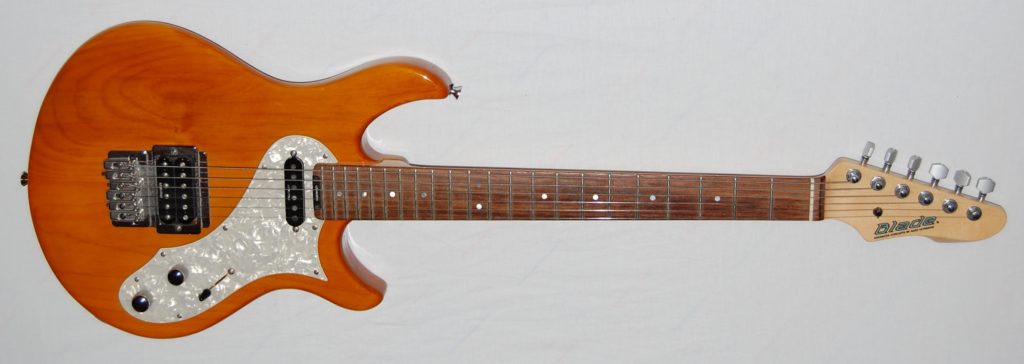
Levinson Blade Durango Magnum 1996 (2002-2023)
One Levinson single-coil, one humbucker. Compact S-shape, hardtail, bolt-on neck, volume and tone with push-push active boost (battery at the back).
This one is a mystery. I doubt if it exists. The guy at Ivar’s didn’t know (it was a trade-in), and I have been searching the net ever since. Actually, I saw one in Helsinki in 2005, but who starts a guitar investigation in Finnish? It seems the Durango usually has a Tele-like body; there is another Strat-like version with HSS and vibrato. I mailed the Swiss factory, they told me this model was made in England around 1996, and the push-push boost is what makes it a Magnum. Gary Levinson had these made at the Patrick Eggle factory in England, but the HS must have been a limited run. I still do not know what the five-way-switch is doing, but all the sounds are distinct and usable.
Tromsø is the city of films from the north – and guitars from everywhere at Ivar’s. I tried a Tele, but it didn’t look and feel right with a rosewood fretboard. Teles shouldn’t have them. So there was this neat little cross between a Strat and something buckerish calling to me, and I said welcome to the family. Played it a lot that summer, leaving the Yamaha in the gigbag. I recorded some demo songs for the project Journey to the North, and still feel it is like meeting an old friend when I pick it up.
But even friends sometimes do part. There is now a player in Oslo who will give it more attention.

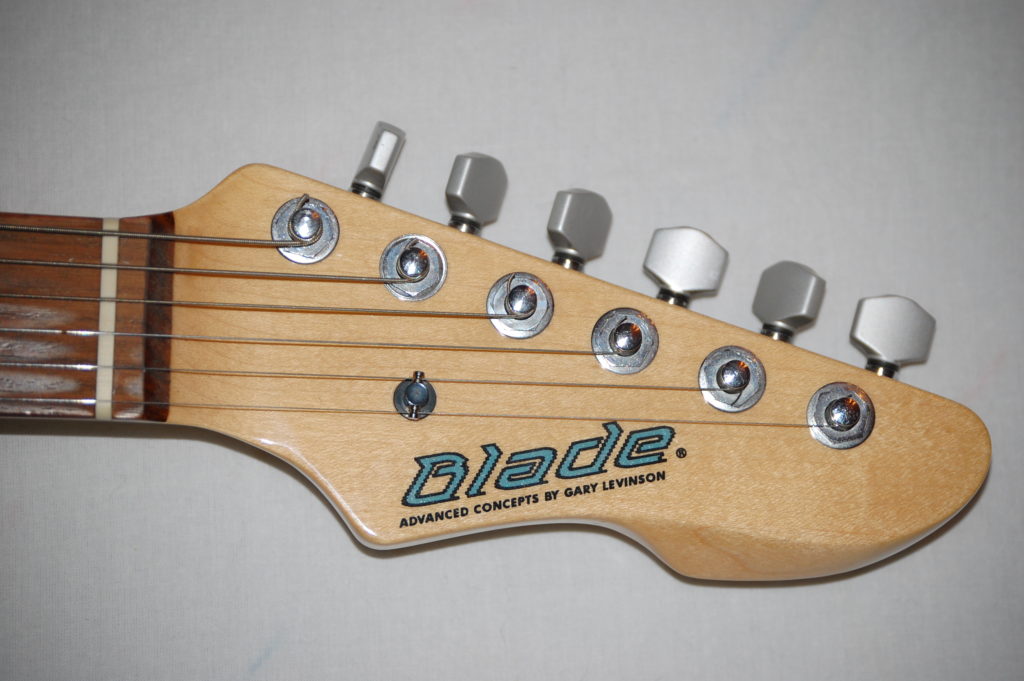
Squier Telemarkster

Squier Telemarkster 2001/2007 (2002-2021)
CY01083277 Neck stamped 06 08 2001
Two single coils, traditional Telecaster bridge with string fastening and individual saddles and pickup; unit later cut in two. Bolt-on neck; the body and headstock later carved by hand.
The very least expensive version of Fender’s budget brand Squier. Squier was a violin-related string factory acquired by Fender in 1972, the name was put on hold when all string production was done under the Fender brand. When Fender wanted to start instrument production abroad, initially in Japan, later in China, Indonesia and Korea, the name was revived in 1982 and the first models came out of the Fuji Gen factory – already renowned for producing Ibanez-branded guitars, the quality at a level that made the big companies slightly nervous.
What is most important to establish when arriving in a new city, is where is the best instrument shop. The biggest in Trondheim is Tre45, with an incredible array of guitars and an inverse number of staff. Not easy to know who to ask, as the staff noodled and the customers knew best. That was close to twenty years ago, things have probably changed for the better. Across the street was Riff, with a more compressed selection of instruments and more eager staff. The bank was closed, the credit card had a £100 limit already spent on the Les Paul Special, so the desired Squier Affinity in Butterscotch Blond was still hanging on their wall when I left. One month later we sold the 22-foot renovation project boat that was nearly never sinking, and a phone call to Riff led to the exchange of parcel for money transfer.
Great Tele sounds, even with the thinner body and bridge-mounted strings. I had this idea of recording a duel between a Gibson and a Fender (or close) on a song called Behind the Monastery at Dawn; it stood its ground.
Knowing that both Leo Fender and Les Paul were notorious tinkerers, I kept eyeing the Squier with tools in hand. Could I turn it into a sitar, with a buzz bridge? First test was a piece of tin can, I was onto something. I had a colleague from the tool workshop in the silverware factory where I was working at the time, cut the bridge plate in two, and hand-tooled a piece of alpacca into a buzzing bridge. I thought Squier New Delhicaster could be a fitting name.
Later, I got my hands on the Jerry Jones with proper buzz and sympathetic strings. The Squier was ripe for new change. Inspired by the Tele silver cutlery design, in turn inspired by traditional wood carvings in the county of Telemark, I set to work with a sharp knife. 25 hours of work resulted in probably the world’s first Squier Telemarkster. I got inspired, and made plans for an even weirder design.
The Telemarkster was sold early in 2021. I like the thought of it getting curious glances out there.
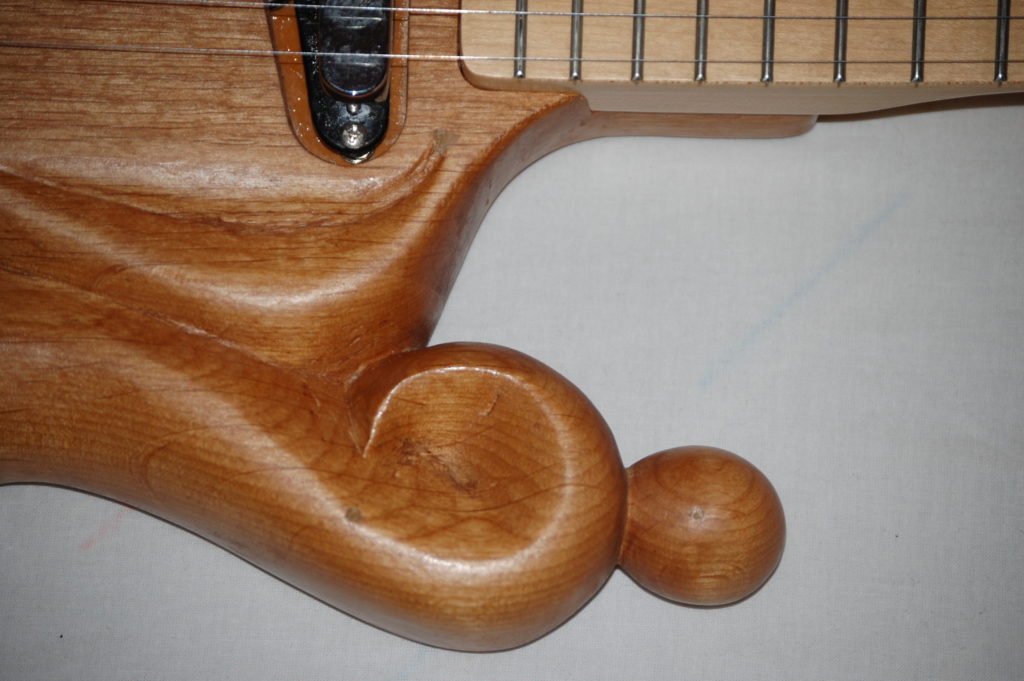
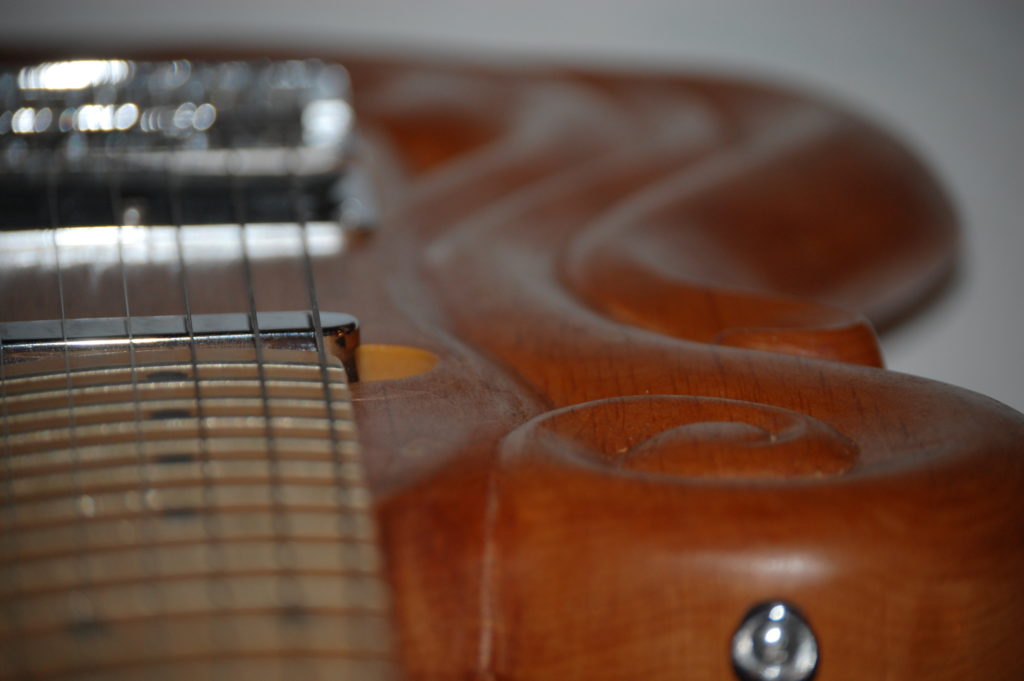
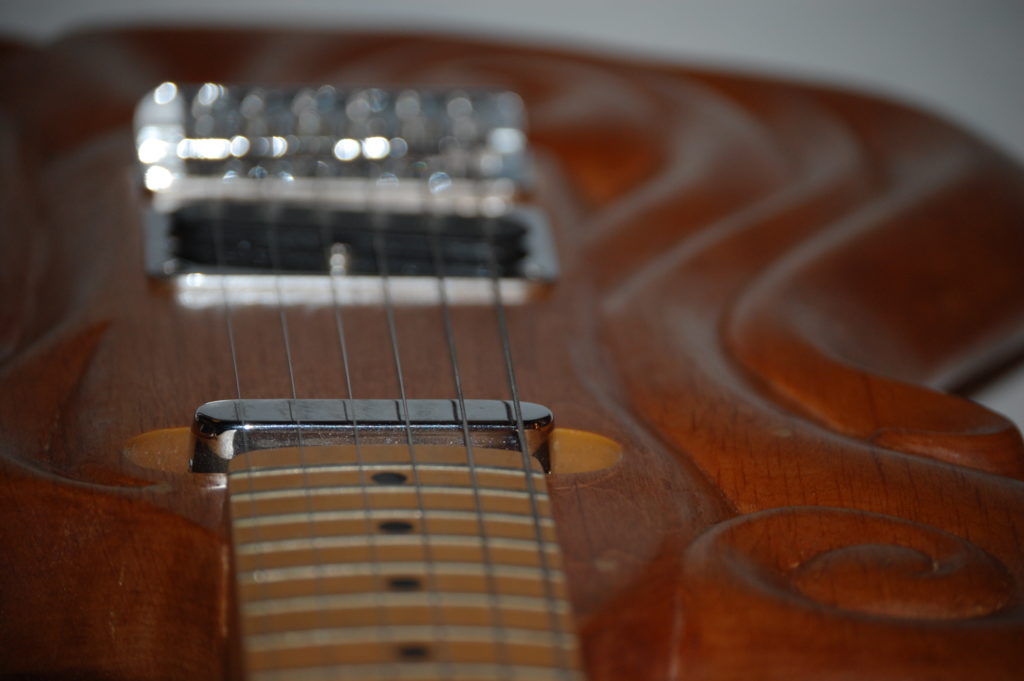
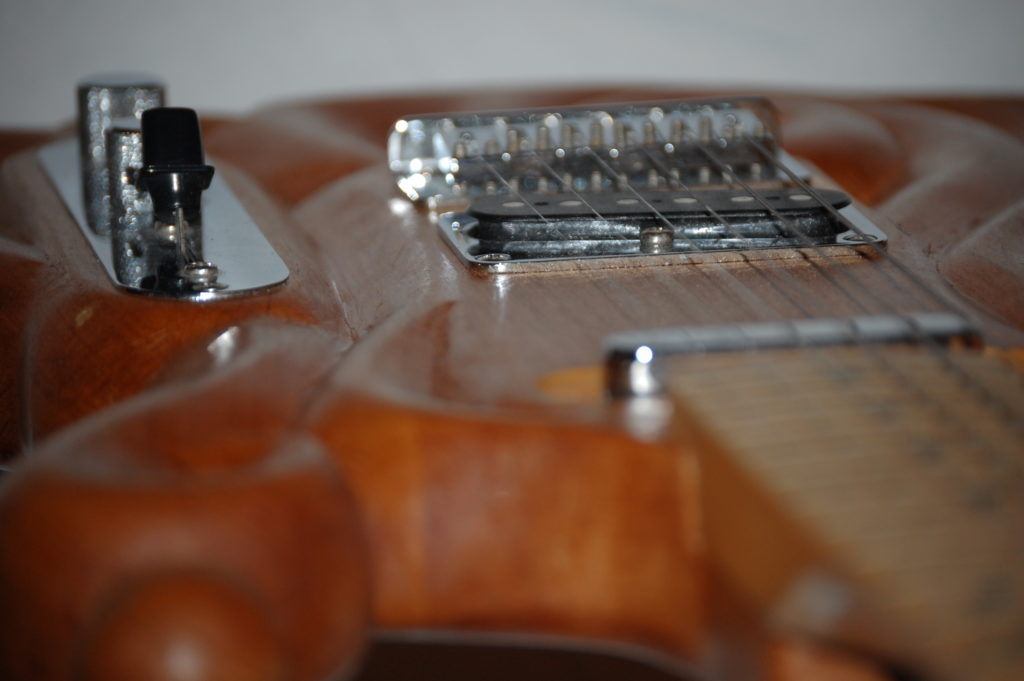
Jay Turser JT-135

Jay Turser JT-135 2002 (2002-2010)
Twin humbuckers, maple body with a centre block and double cutaway, bound and set neck
According to their website, Jay Turser is an American who has organised production in China and distribution via Internet since 1996. The quality of Chinese instruments has really improved these last years, even though the design is far from original in this case. Tønsberg Musikkforlag in Larvik was one of the first stores in Norway to offer these models.
I know the words “I have always wanted” tend to pop up at times, but who doesn’t fancy an ES-335? The difference between £3000 and £400 was quite weighty; even then the Joe Pass had to go as I had never really come to terms with it.
The JT became an instant favourite, adding very G-like tones to songs like Taking Flight. It feels like one of the fastest guitars I’ve played, and I’ve used it in public, most notably on the trio gig at Amadeus on July 22nd 2005.
Some years later it was replaced by the Gibson ES-135, and yet another centre-block in the shape of a 1976 ES-345.
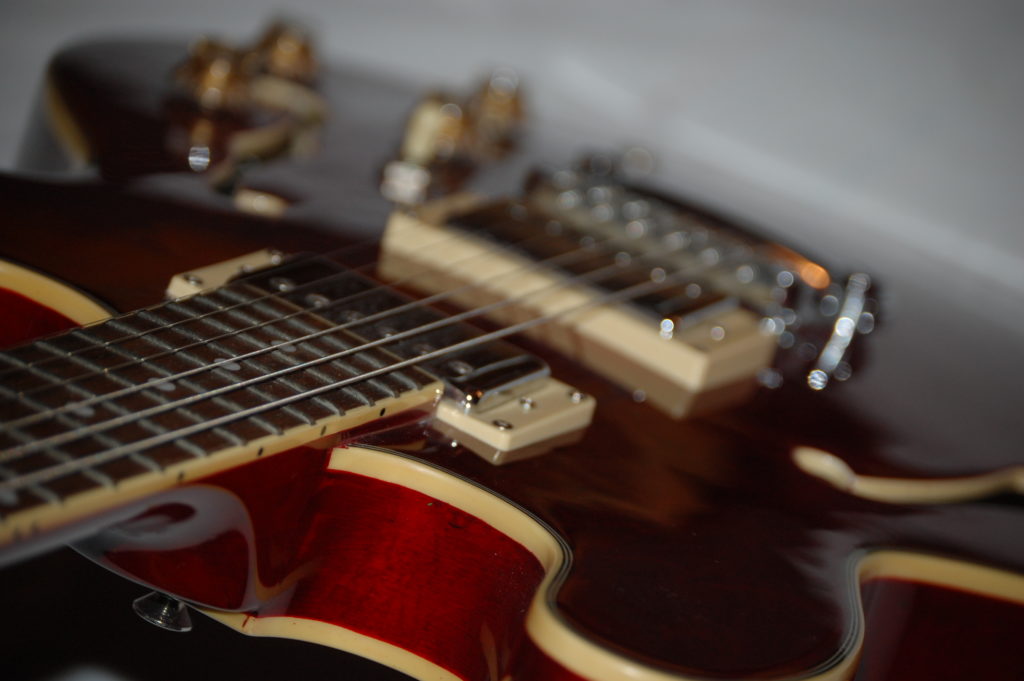
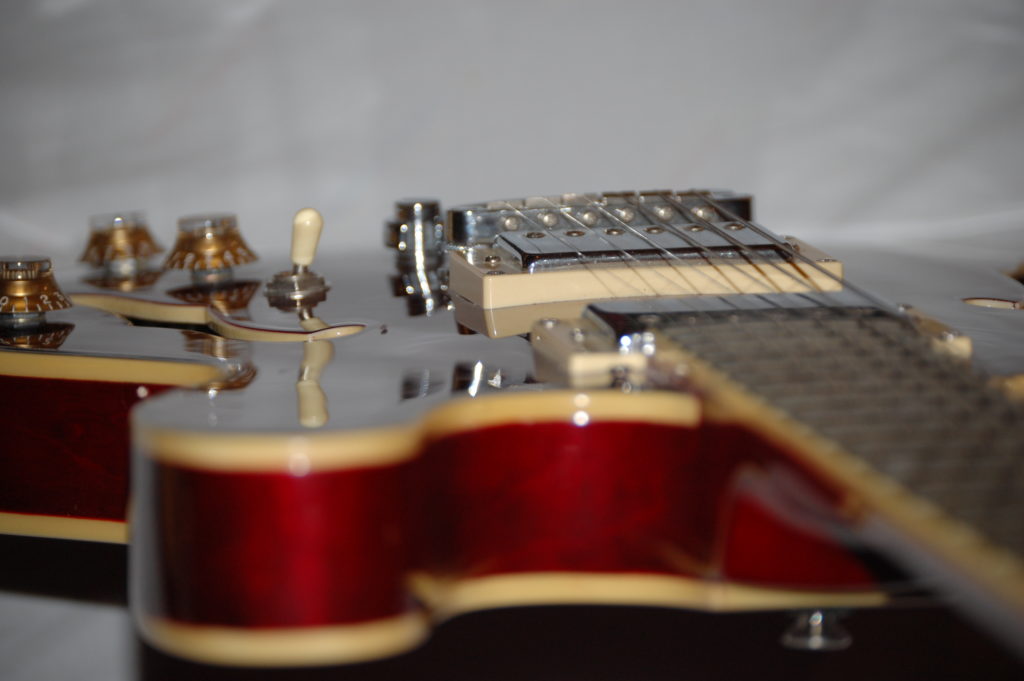
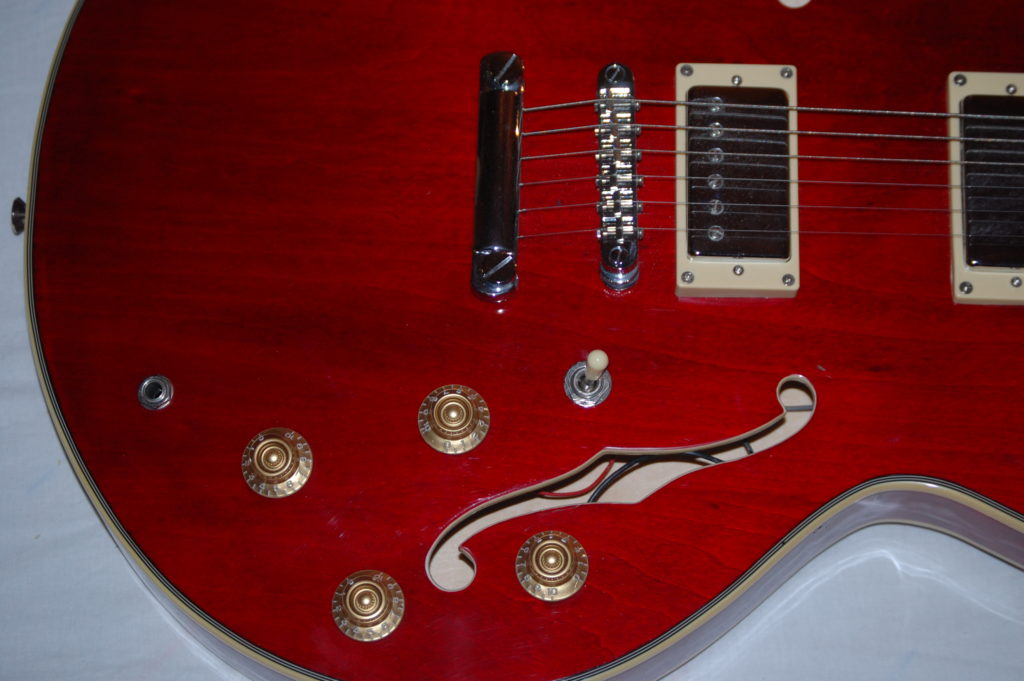

Epiphone Les Paul Goldtop
Epiphone Les Paul ’56 2002 (2003-2005)
Two P90 single coil, stoptail and tune-o-matic bridge, alder body with maple cap, set neck
Les Paul Gold Top was Gibson’s first solidbody Spanish (as opposed to Hawaiian, see the lap steel presented elsewhere) guitar. The story comes in two different versions according to either Les himself or the Gibson engineers; however, the first models had an impractical trapeze bridge/tailpiece that was changed to wrapover and eventually to the stoptail like on this budget reissue from Epiphone. The next improvement was changing to humbuckers and a different colour scheme, and the rest is, well, investment.
Again, an “I-have-always-wanted” guitar, especially since my teacher Odd-Arne Jacobsen had a gold top. His was a late sixties Deluxe with the mini humbuckers, but the colour matched perfectly. Bought in Edinburgh on a trip including driving a left-side-steering car on the left side of the road, and sleeping in a castle-cum-hotel where everybody added “luv” to every sentence. But then I seriously considered upgrading to a proper Gibson, and it was sold. I have regretted it ever since, of course, but then again the original replaced my regrets some years later. But before parting we made some good music in the Journey to the North period, especially The View and Parallel Ride.
Once again the proper Gibson came into my hands some years later.
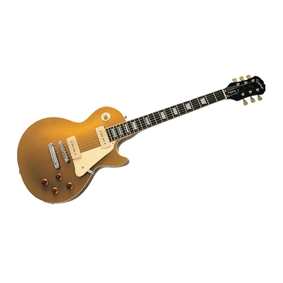
Falcon bass

Falcon 5-string bass (2003-2018)
Bolt-on neck, PJ configuration, twin volume, master tone
No information available. Budget brand from somewhere in the East.
First thought: Having a proper bass would be OK. Second thought: Having a proper bass is fun! Adjusting from the Dano baritone (BEADF#B) to BEADG is easy. Possibly the space in my studio is too small, as I have problems coming to terms with anything lower than the usual E.
Up to January 2006 I had this one bass, and it’s on everything. I turn up the P-pickup (neck) and roll the tone all the way down, run it through Squeeze Bass on the 1180 and play with a pick. Oomph.
Put it up for sale some years later; met this guy named Stewart, and out of the trading emerged Band of Traders.
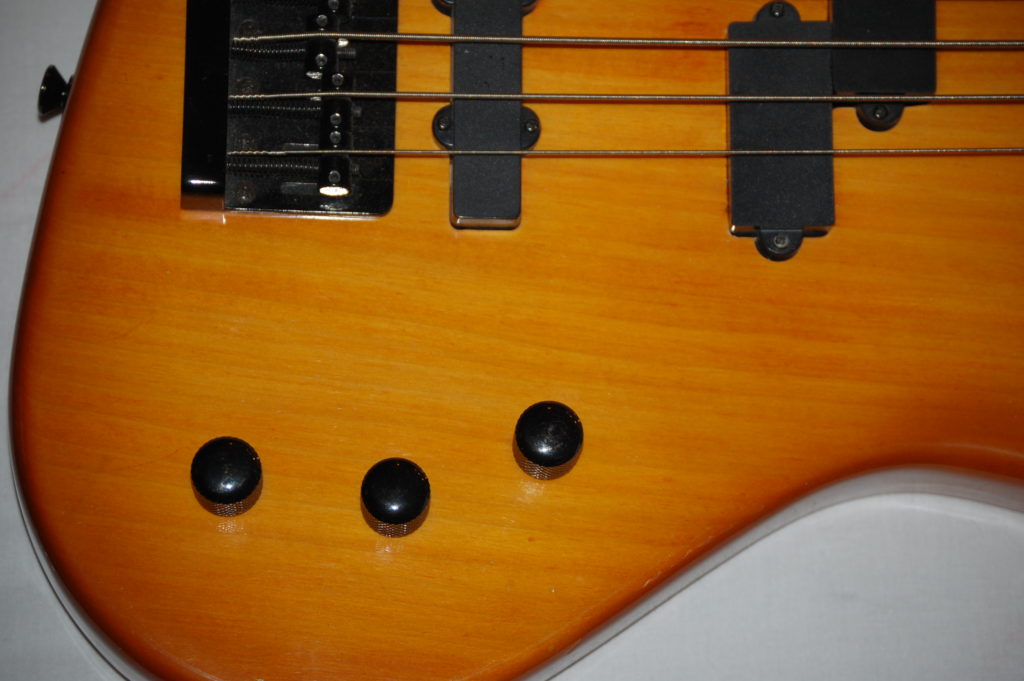
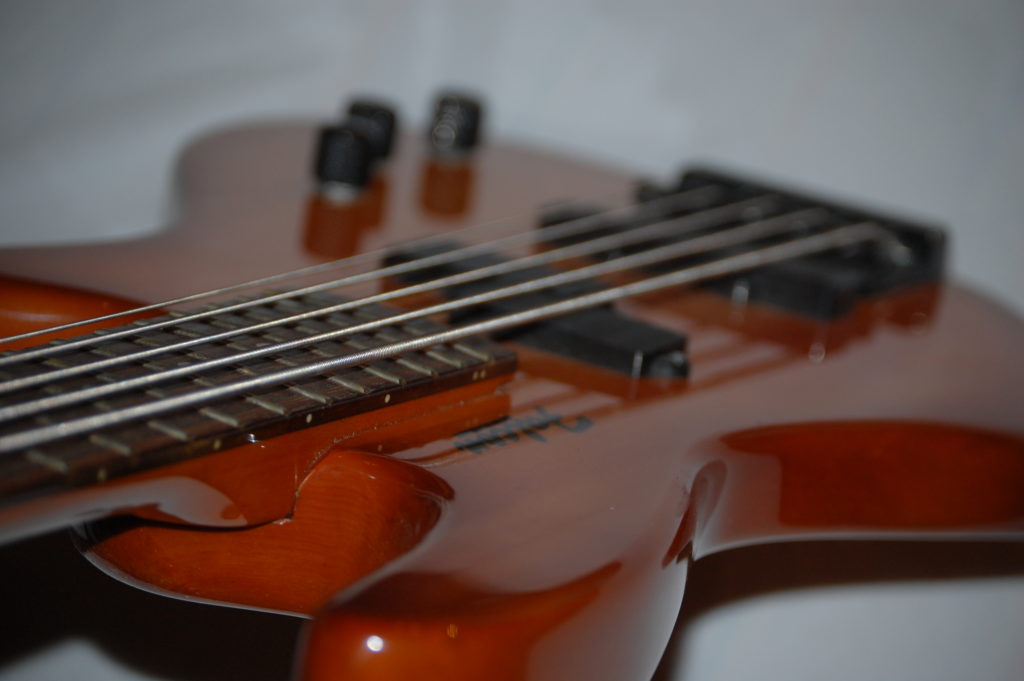
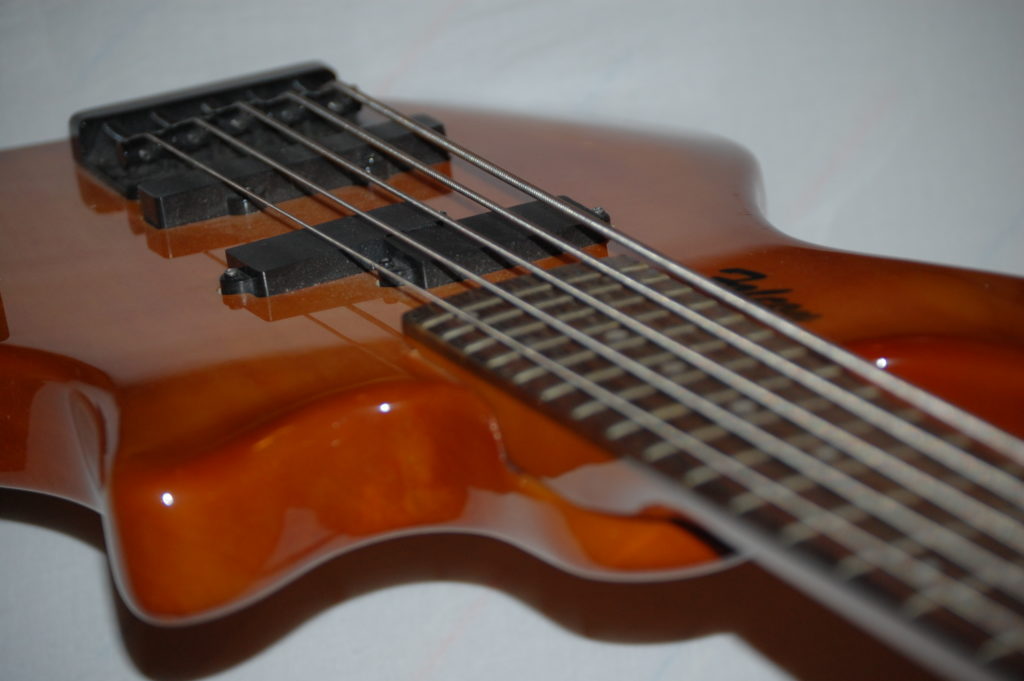
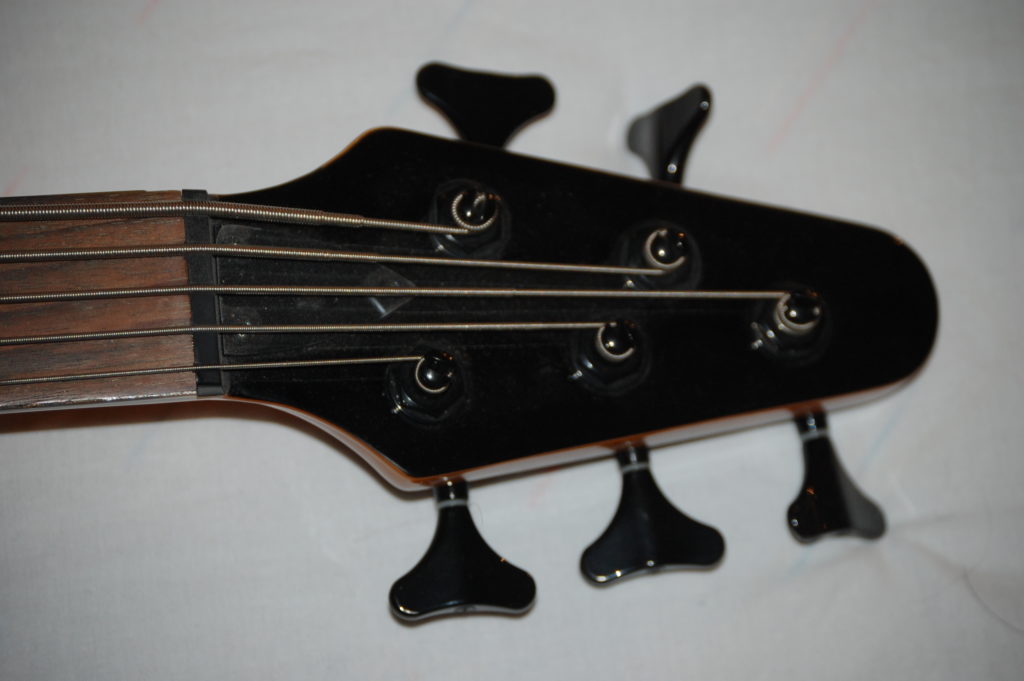
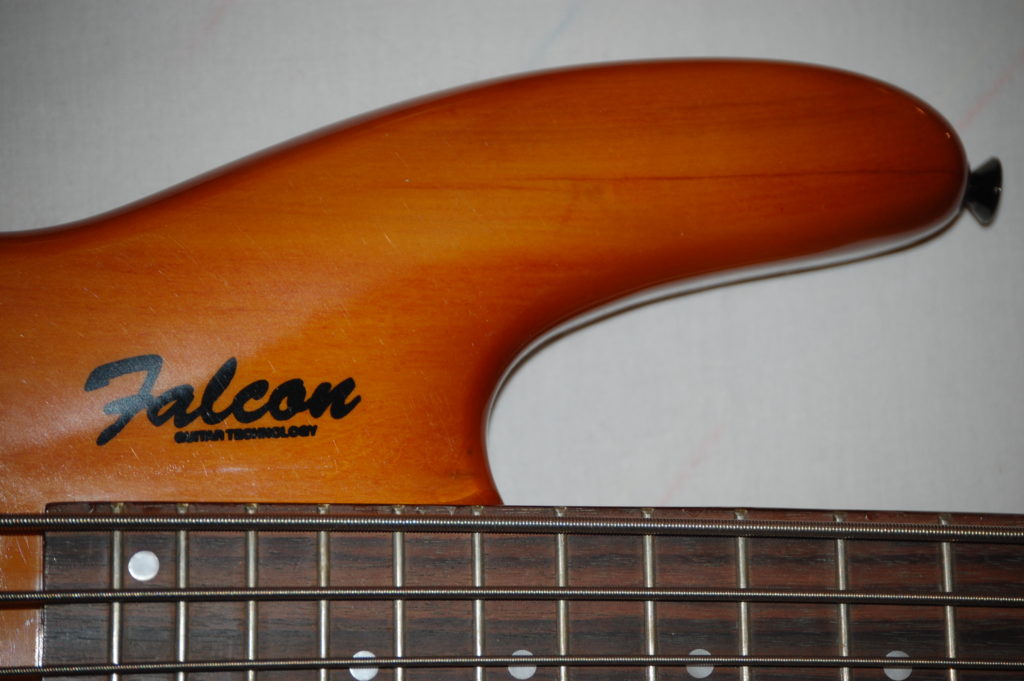
Ibanez AFS75T
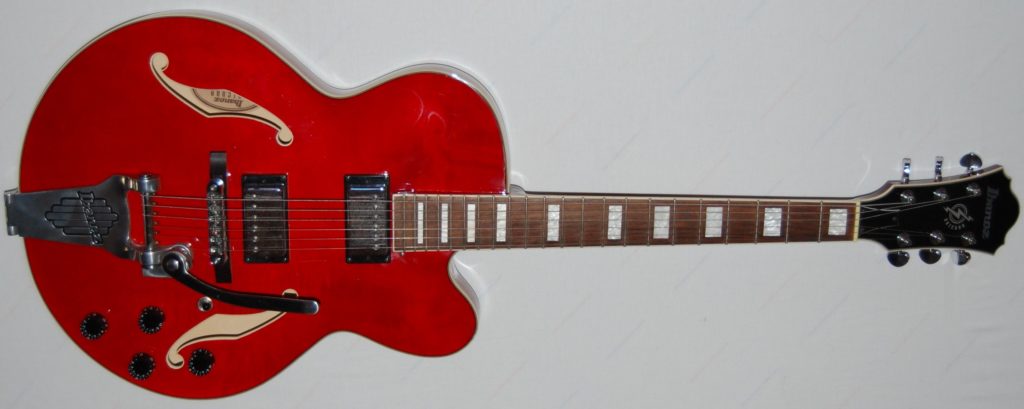
Ibanez Artcore AFS75T (2004)
Thinline hollowbody with licenced Bigsby, two humbuckers, venetian cutaway
The Artcore series are traditional jazz and country-styled guitars taking after both the big G’s, in affordable Ibanez build quality. Aesthetically, though, the weird downward arching by the neck makes it look like something was bent into place.
Again a purchase at Ivar’s in Tromsø, to have something to noodle on between screenings at the Tromsø International Film Festival. A small mark took a little off the price, and it fit well into an old Epi case for a safe flight home.
Love Decides My Way, one of my personal favourites, was written in the hotel room on this. I tend to write things in hotel rooms. Played in public at Kragerø Session in 2007 (both song and guitar). A few years later I found a Gibson ES-135 and put a Bigsby on it, and the Ibanez AFS75T found a new home elsewhere.

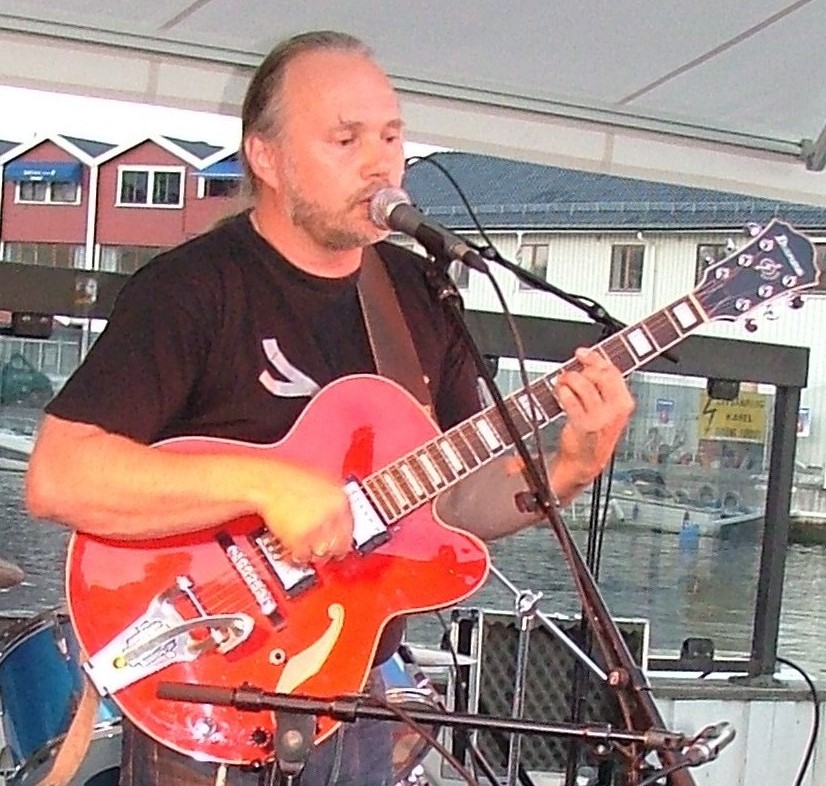
I’m even wearing a TIFF t-shirt.
Burns Steer
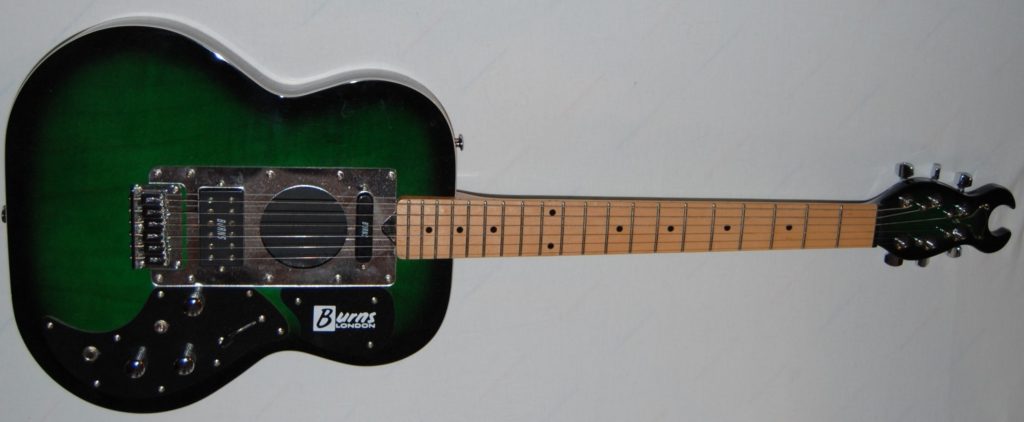
Burns Steer 2003 (2004-2021)
0112012
Thinline body with round soundhole and no cutaway, bolt-on neck with maple fretboard, one humbucker with coil-split switch and one singlecoil
Burns has a long history in UK guitar making, with tight connections to Hank Marvin and the Shadows period. Jim Burns has been involved with a number of companies bearing his name, Burns London being the latest. They produced recreated classics in China and Korea, my green one among the Korean ones. The Chinese Steer came with a cutaway.
Belco in Porsgrunn was moving house, offering a 40% discount from the old location. I thought they were open on Saturdays, but the door was closed. I chanced a phone call to the owner, who actually took the time to open the shop for me. Marks for service and an extra bottle of polish.
Playing very nicely, sounding a little like a Tele with some extras, and looking like nothing else. I needed some clear stabbing rhythm chords, and preferred this to a Tele, in fact.
But times are changing, and I was looking to steer (sic) the collection in a more specific direction. Some of the odd ones out had to go, and along with the Parker and the personalised Telemarkster the Steer was shipped to Oslo in February 2021.
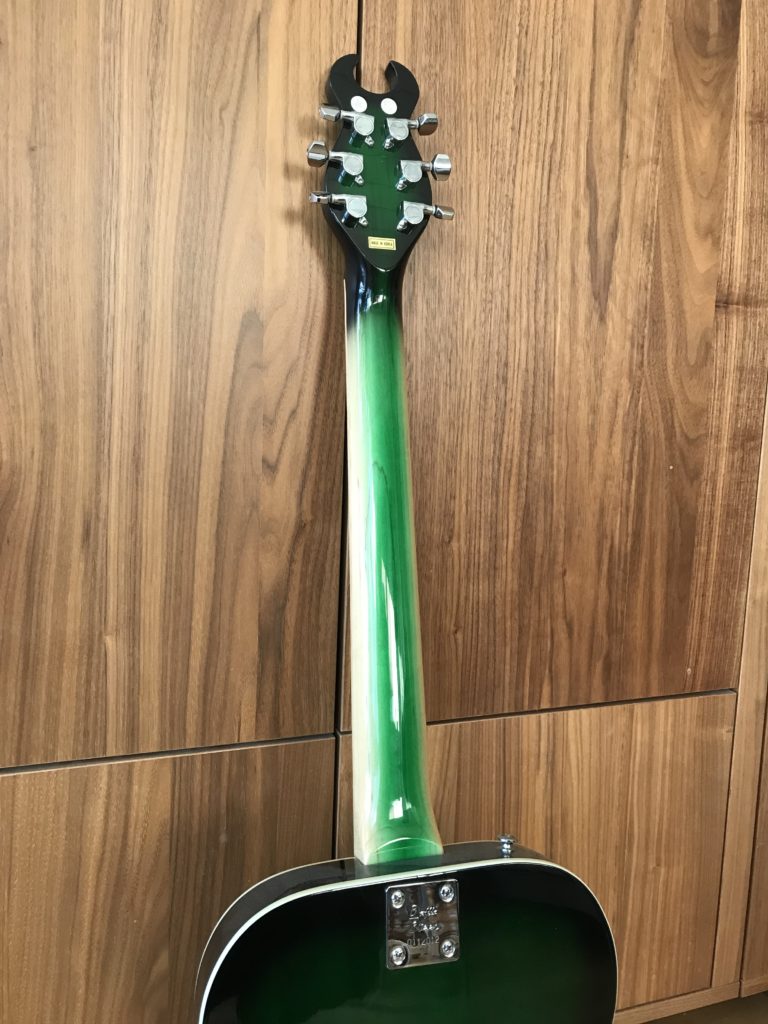
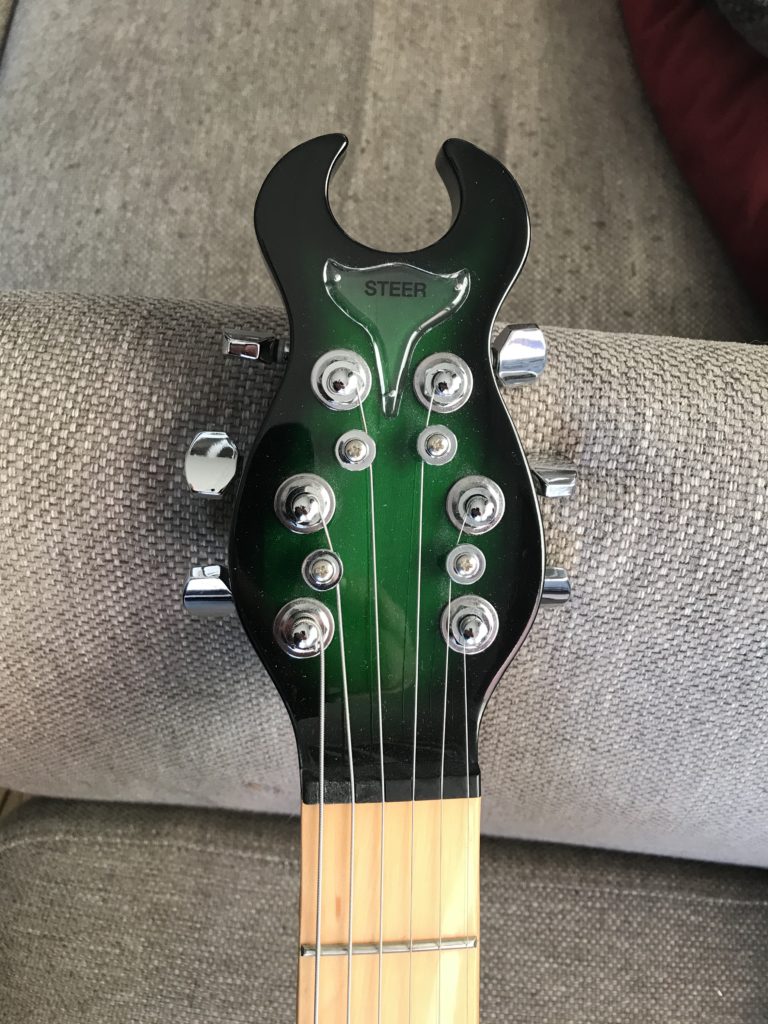
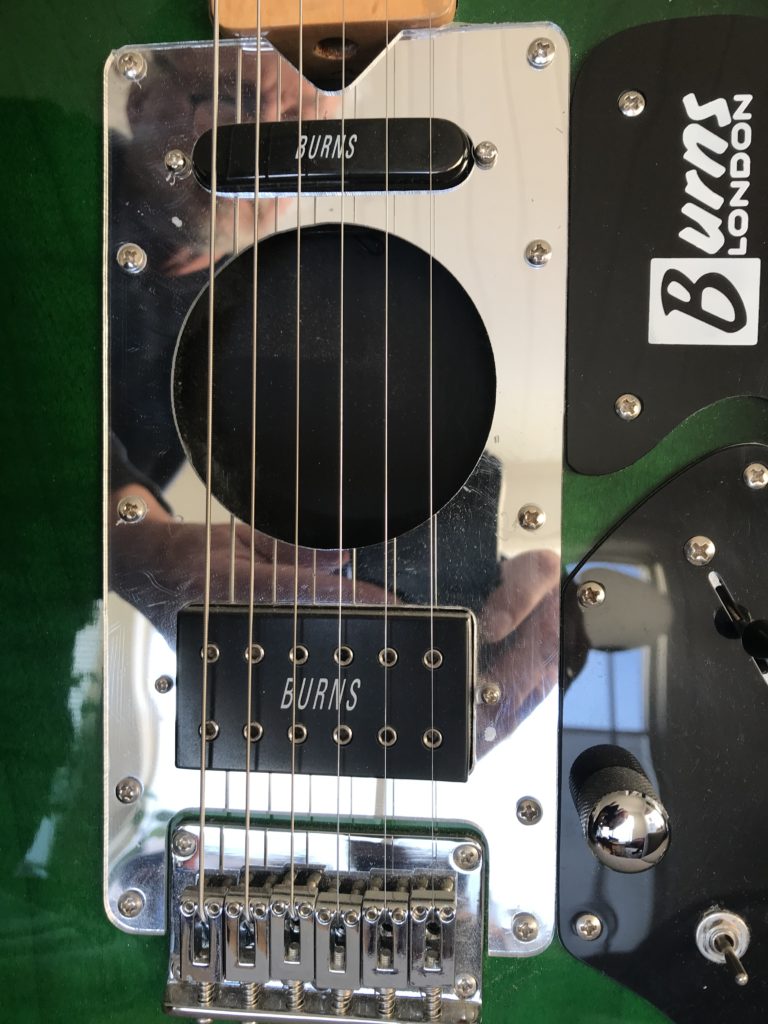

Behringer iAXE

Behringer iAXE 393 2006
N0603811612
S-type with three single coils, volume and two tone, bolt-on neck with maple fretboard; USB and headphone connections, included software CD for recording to computer
Behringer is based in Germany, producing their items in the East. They are well-known for mixing and amplification tools, effect pedals, and their V-Amp was, in the early 00’s, a good alternative to the Line 6 Pod. As far as I know, this is their only guitar. I have a condenser microphone, a 12-channel mixer and studio monitors from Behringer.
I saw it on riff.no, and at £100 the price was no hindrance as I was on the lookout for an easy way to record on the fly. We were going north again, and actually had them send the guitar to our temporary address.
Things did not turn out as planned. For one, I was hired in as a museum and exhibition guide for groups of schoolchildren at Maursund Gård and was quite busy for the whole of September 2006. Secondly, the guitar didn’t want to talk to my friend Dell at all. Worked well through a small computer speaker at the kitchen table with a view of the Lyngen Alps, but none of it could be preserved.
I never got around to calling support. Back home the Boss 1180 welcomed my songs without protesting, and both Fenders and Gibsons were lined up on my wall. I sold it to a drummer who wanted to test his noise-making abilities on a six-string.

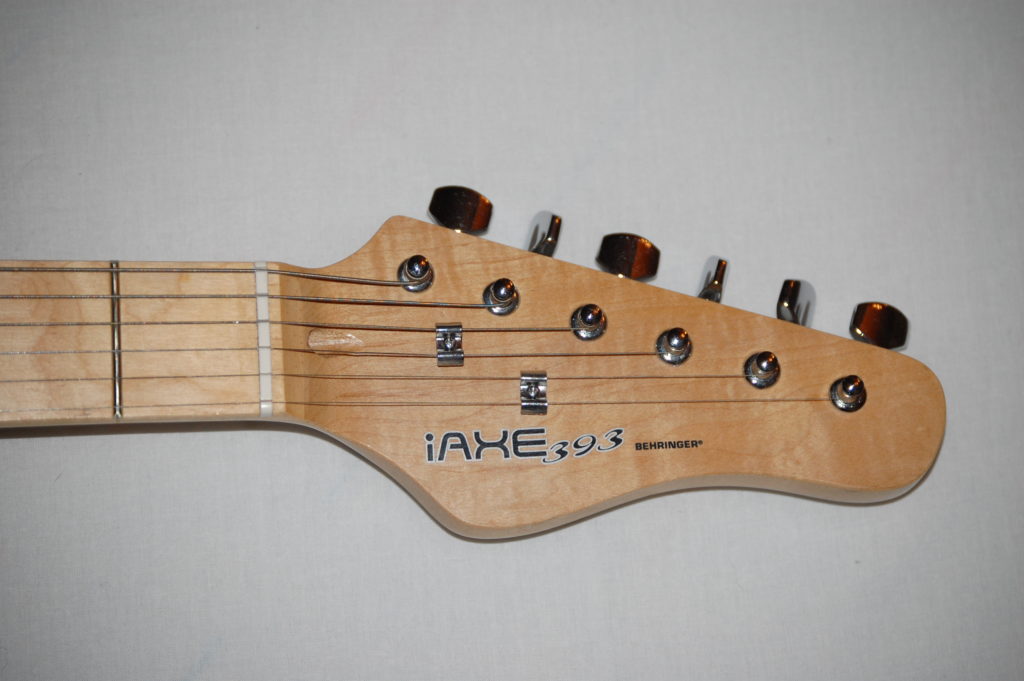
Gibson Les Paul Standard

Gibson Les Paul Standard Iced Tea 50’s 2005 (2006)
00635572
Mahogany body with flamed maple top, two Burstbuckers, two volume two tone, bound rosewood fretboard on chunky 50’s neck. All that is needed.
Jimmy Page, Koss, early Clapton. My heroes. And many others who I later have discovered were Les Paul players.
”Only a Gibson is good enough” it said on the box. All due respect to other makers, this is, for me, the Standard. This is why fourteen-year-old me chose an Ibanez 2351M. The shape, the set neck, the carved top, the colour, the weight, and of course the sounds. The guitariest guitar.
In a severe shopping mood, as the computer seemed to have reverted to steamboat speed, in a few days arrived a new compressor, a new laptop, and a Gibson Les Paul. My credit card took some time to recover, but we all get over things, don’t we? The first one to get a permanent wall hanger in the living room, close to the valve powered Bravo under the side table. Location has changed, but the Standard is still the standard.
So the only thing that could make me consider selling, is the opportunity to go back to the seventies again. A genuine 1977 model proved irresistible when tested in London in 2024, so I decided to make a deal with a nice guy who had a couple of amps to spare.
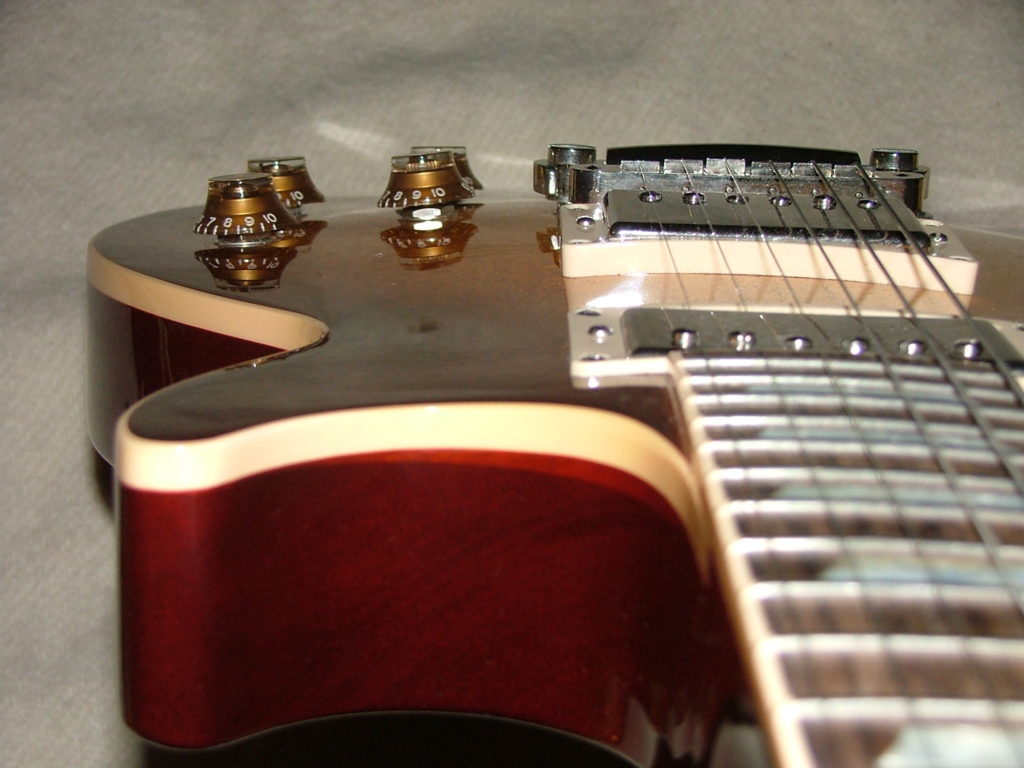


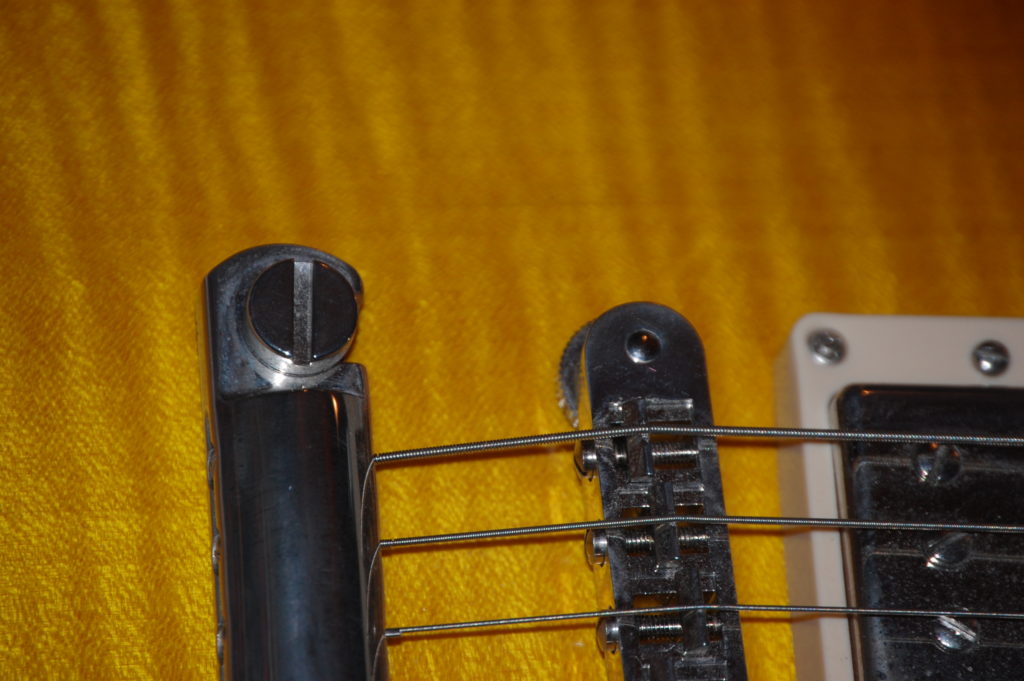
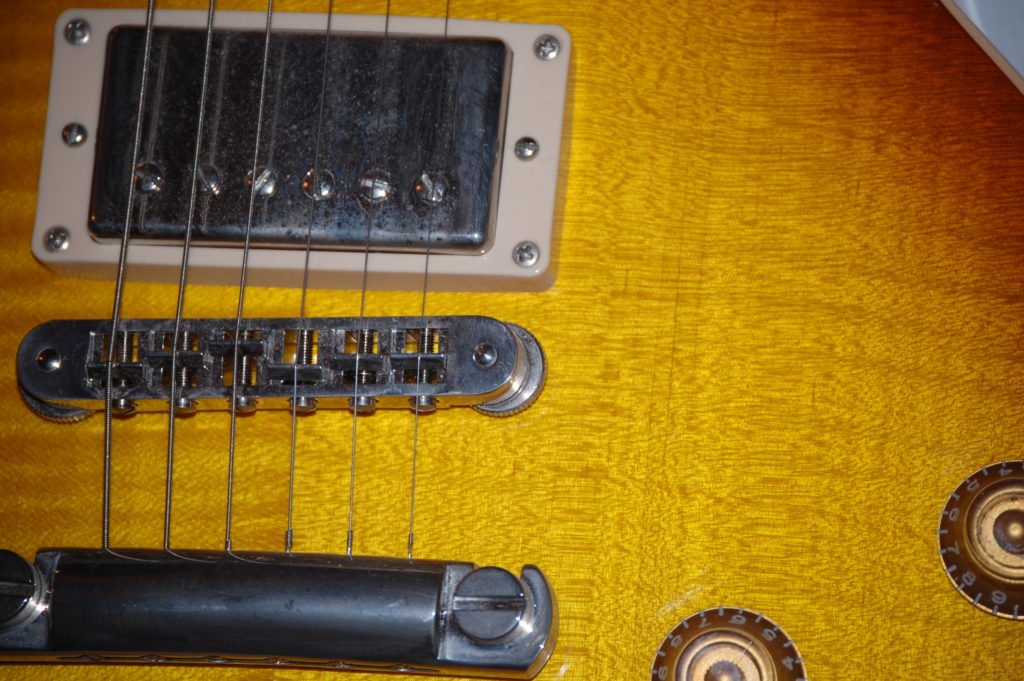
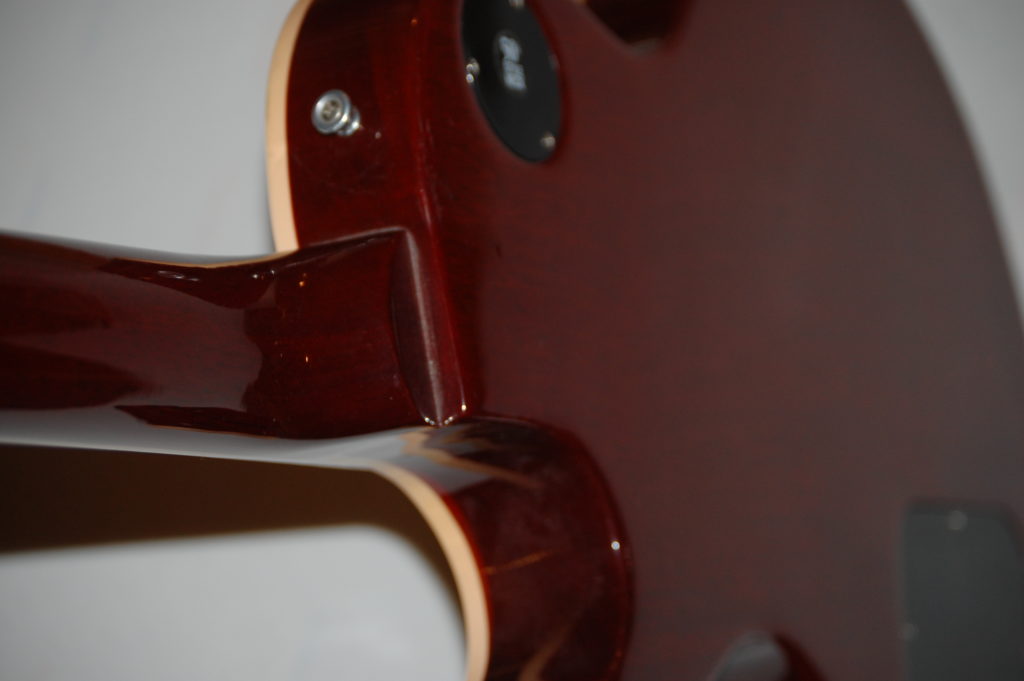

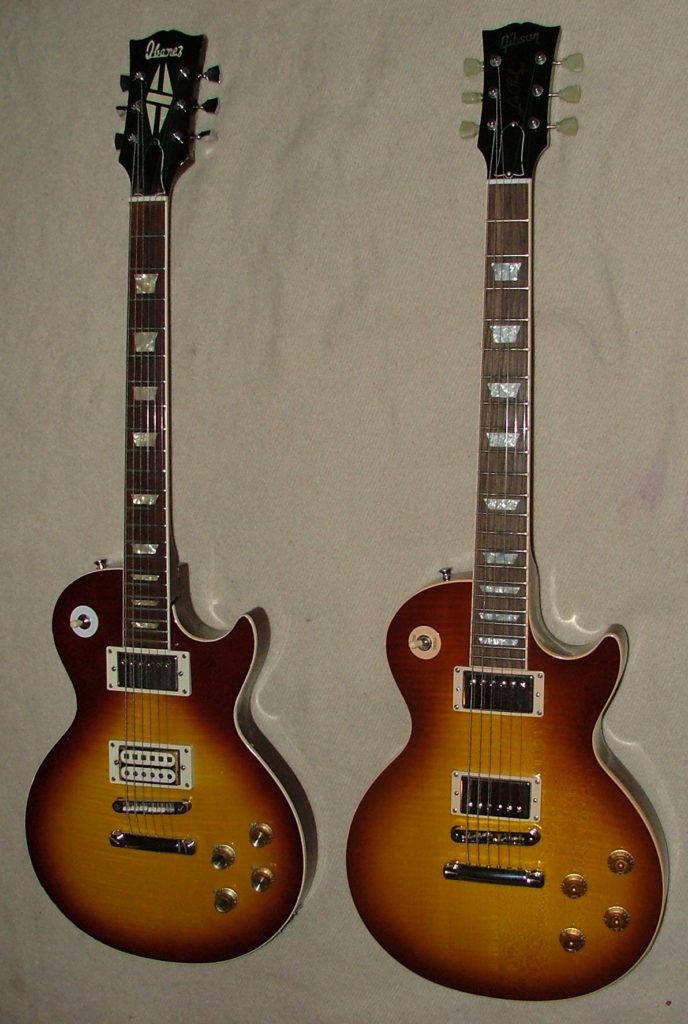
Ibanez Custom Agent

Ibanez 2405 Custom Agent 1976 (2007-2020)
Modified to three humbuckers, each with phase/off/phase switch, master volume and tone, set neck, binding and mother-of-pearl inlays in abundance.
Quite unique take on the Les Paul from Ibanez in the wake of the lawsuit era, stepping from copies to their own designs. I won the auction £2 under my bidding maximum, and the Custom Agent cleared customs from Germany without being strip-searched.
I believe the modder was inspired by the switching on Brian May’s Red Special, and there are some interesting sounds from the numerous pickup constellations.
In the restocking of my collection around 2020 it moved on to a new owner, ironically because of its originality.

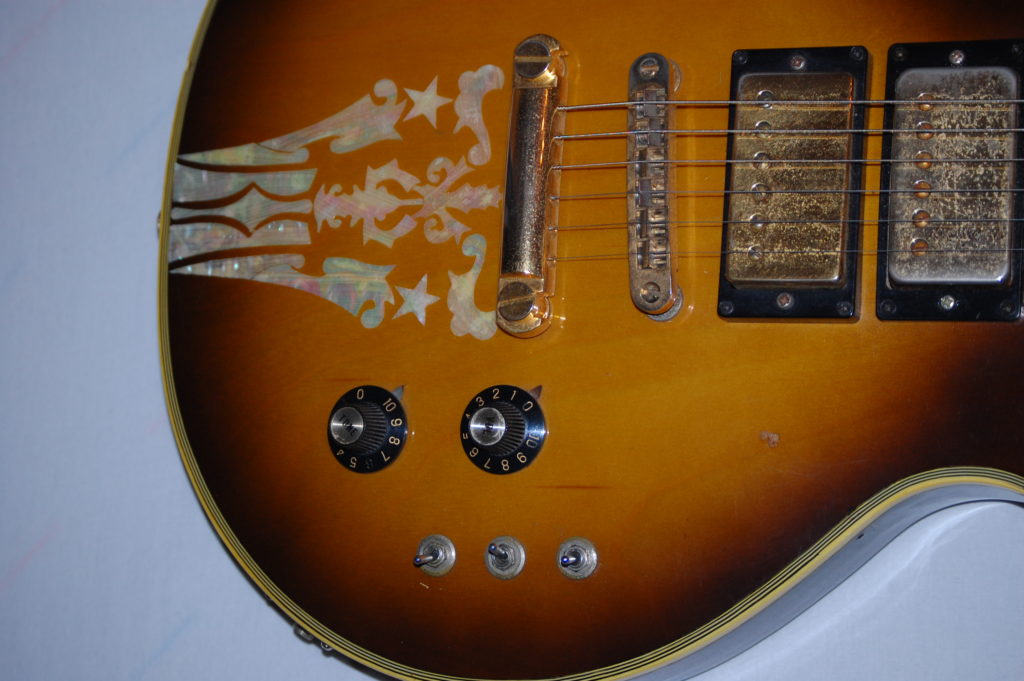
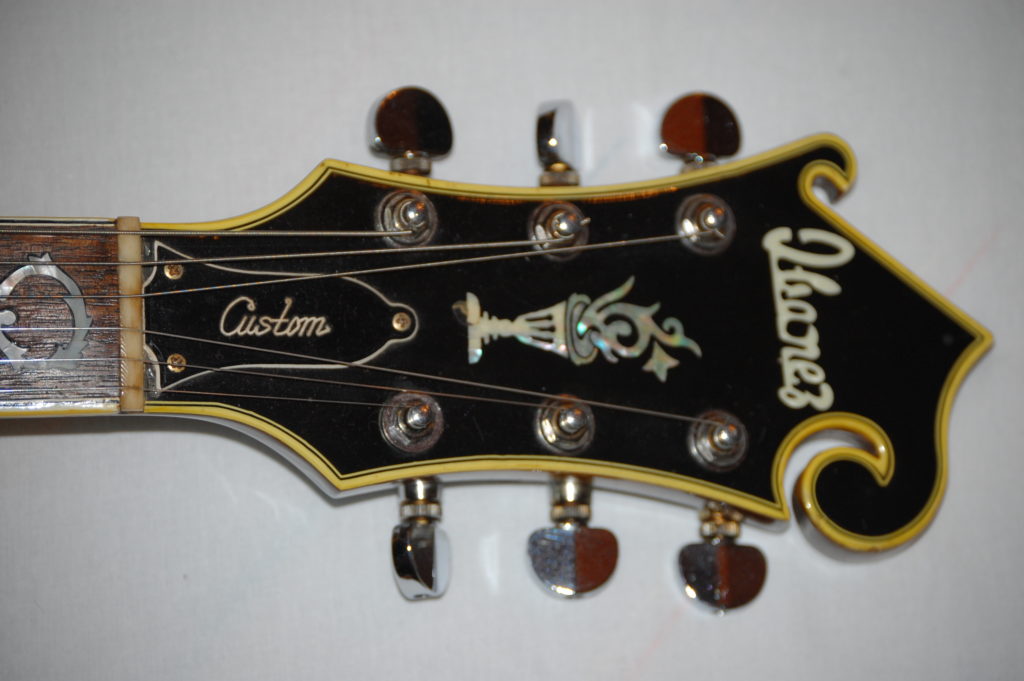

H&S Doubleneck bass
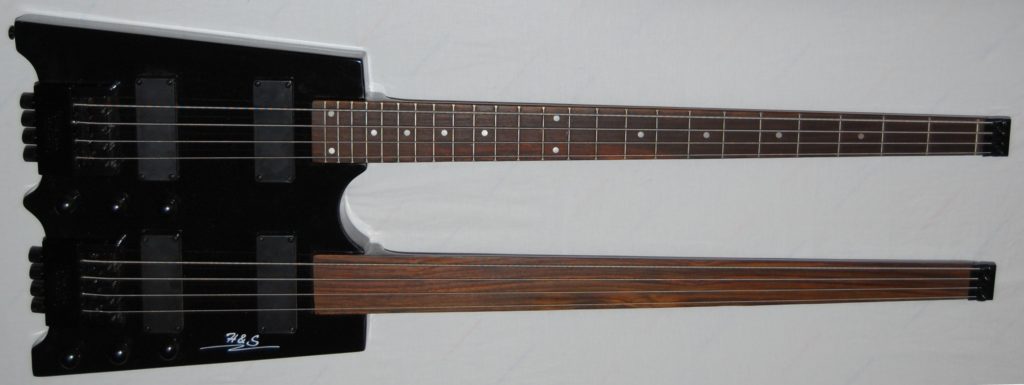
H&S Doubleneck; bass & fretless bass (2007-2015)
”Steinberger-type” with individual volumes and master tone, times two. Never heard of this firm.
Found this German firm on eBay, it seems they produced on order, and I paid around £150 for this. Incredibly heavy, not the simple elegance of the Steinberger, but the sounds were OK. I had the idea of recording a song using only the Dano six-and-baritone, the Epi six-and-twelve, and this. In never got around to it, and one dark night at a petrol station in Oslo instrument and money was exchanged. I later got a Squier fretless that didn’t feel, look and sound like a steam hammer.


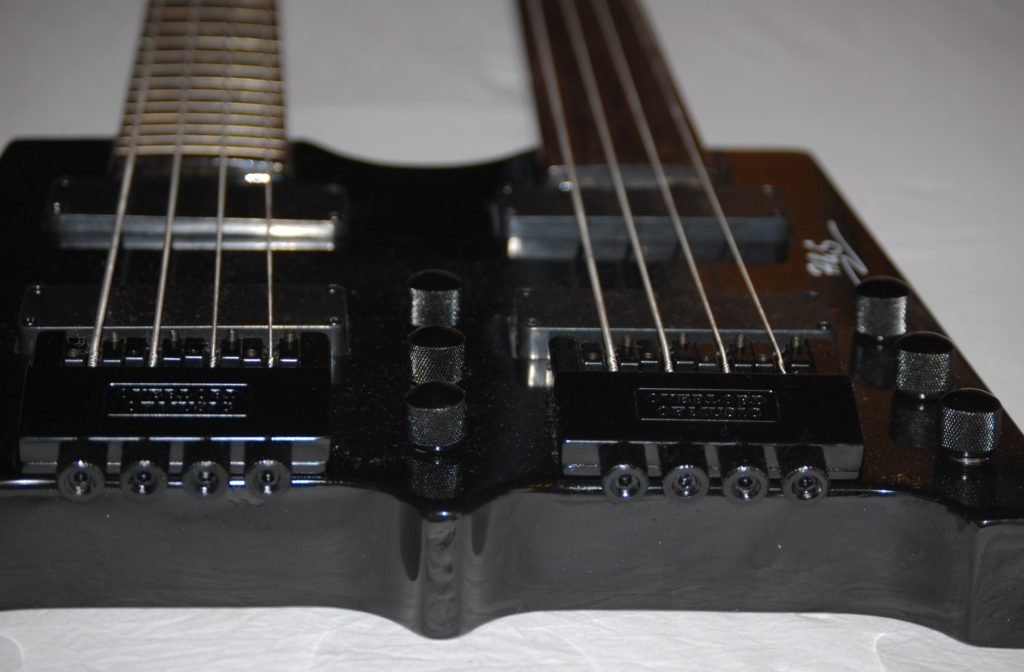
Gibson Melody Maker

Gibson Melody Maker 2PU 2007 (2008-2015)
013170662
1959 was a good year. In addition to other events Gibson launched their most basic model that year, even simpler than the Junior. Thin body, one single coil, narrow headstock. The shape looks right, the neck feels surprisingly solid, and even with single coils it is definitely a Gibson. Reissued in later years; I became aware of it in 2007 as a side track on my quest for a Junior. I ordered through Musikkbørsen, but it turned out after some time of waiting Gibson could not deliver.
Then one appeared on eBay. It seemed a little strange that a clothes and accessories shop could provide something the music store couldn’t, but stranger things happen on the web. To my surprise it appeared with two pickups, and plugging in, the reaction was «wow». Playability and intonation, and the sound of a basic workingman’s tool.
Glancing at the serial number, I became slightly worried. In all my guitar literature (four shelf-feet, approximately) the simple Gibson system is praised for consistency: Eight digits, first and fifth denote year. 00635572 means 2005. But here was nine, and a pickup I couldn’t remember ordering. Bought from a webshop with the trust-inspiring name of Amusetrend.
Fear not. A mail to Gibson cleared it all up.
Dear Erik,
Thank you for your interest in Gibson guitars.
The guitar is indeed a Melody Maker Dual Pickup in Vintage Sunburst finish, Chrome hardware, made in 2007 in Nashville US.
Actually, the guitar has been order by Musiciensfriend which is a very important Gibson authorized dealer, and the guitar was an special order of them.
Regarding the serial number with 9 digits, in July 2005 Gibson changed the serial number system from 8 to 9 digits.
From July 2005 on the key is this:
YDDDYBPPP
The sixth number is now a batch number. Batch 0 starts at the beginning of the day, and once we stamp 699, the batch number will change to 1. The first 5 numbers remain the same, the last 3 numbers remain the same, the only difference is the addition of this batch indicator.
Hope that helps.
Kind regards,
Marcelo Pineda
Customer Service
So 013170662 means it was finished on May 11th 2007 in the official factory. This collector’s heart rate sank from speed metal to Black Sabbath.
Eventually I decided to go for a proper Junior. That is another long story with a twist at the end, and the story of my Melody Maker ended with a buyer in Drammen in 2015.
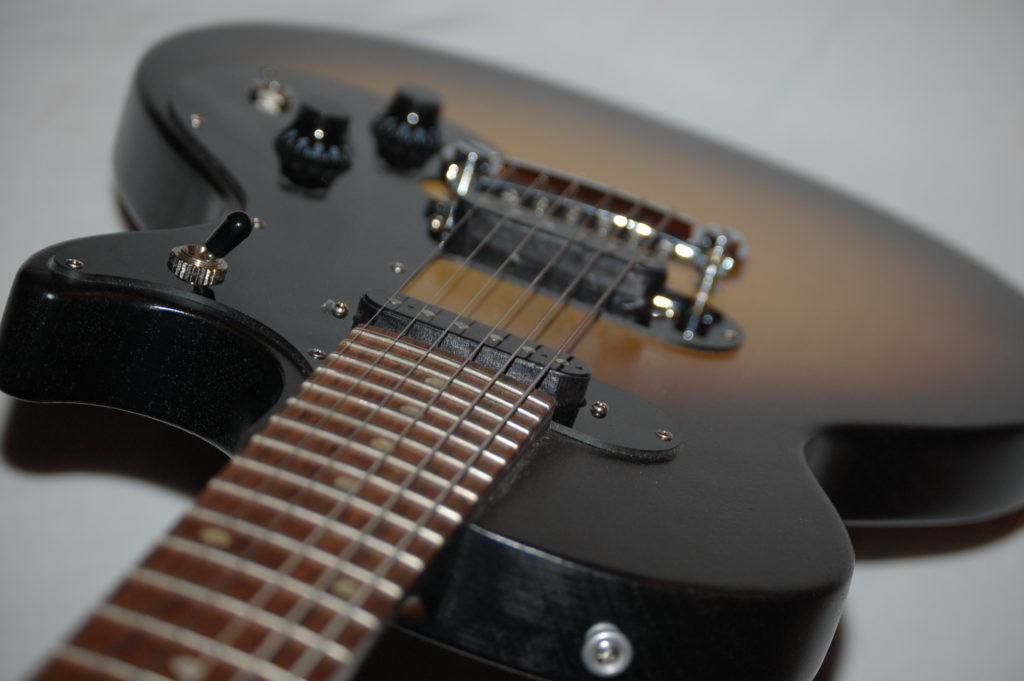


Gretsch Electromatic

Gretsch Electromatic (2009-2018)
Eastern-made version of apparently solidbody, actually hollowbody singlecut with gold metallic top and standard G control layout.
I had this idea of «one of each» after realising this gathering was becoming a collection. Gretsch was a brand I wanted to include, especially as Mitch Mitchell was playing a Gretsch drum kit; I even learned to draw their logo as I spent boring school lessons at thirteen portraying Jimi and his band in my journals. I enjoyed playing this, but as my collection came closer to a purpose, it was sold to a guy who had a houseful of guitars and even less of a purpose. I enjoyed chatting with him on delivery, and would have jumped at the opportunity to sort out his incredible number of instruments and give the pearls a chance to shine.
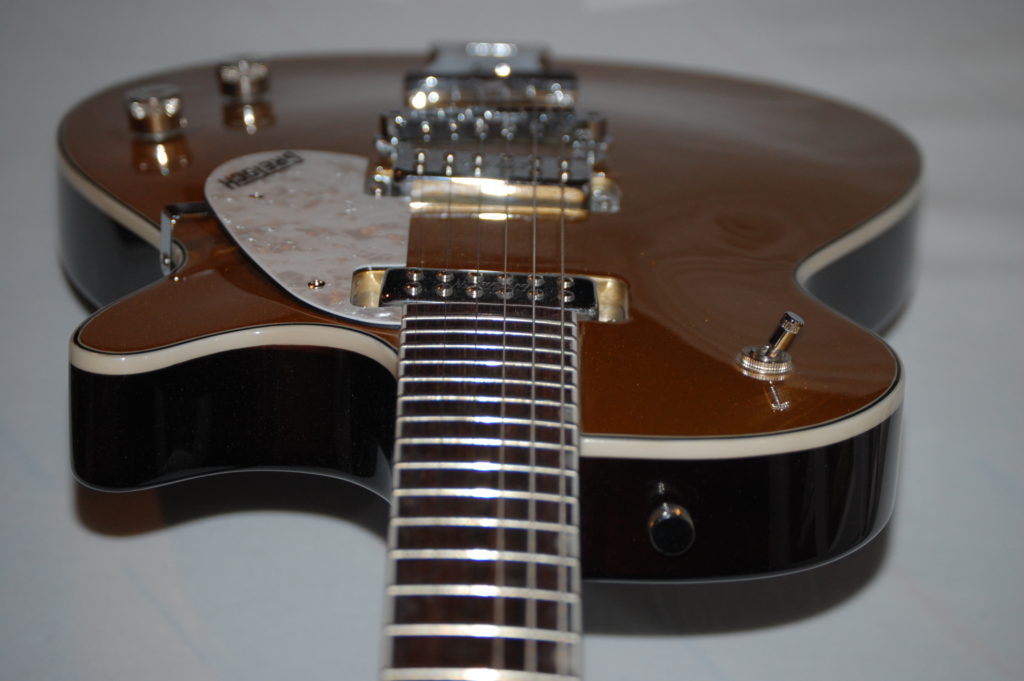
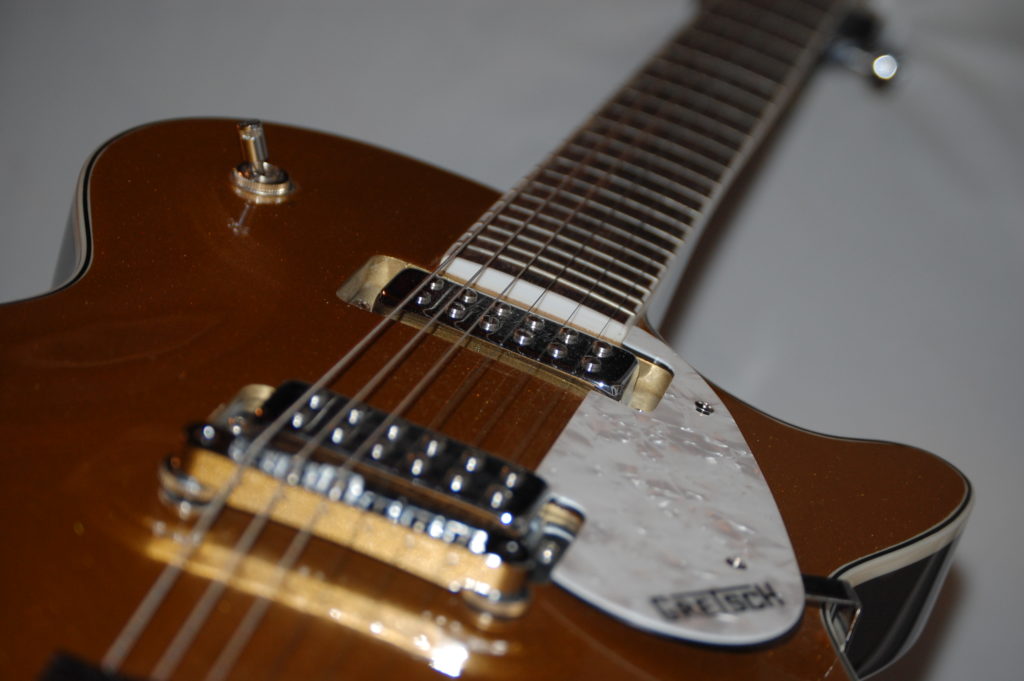
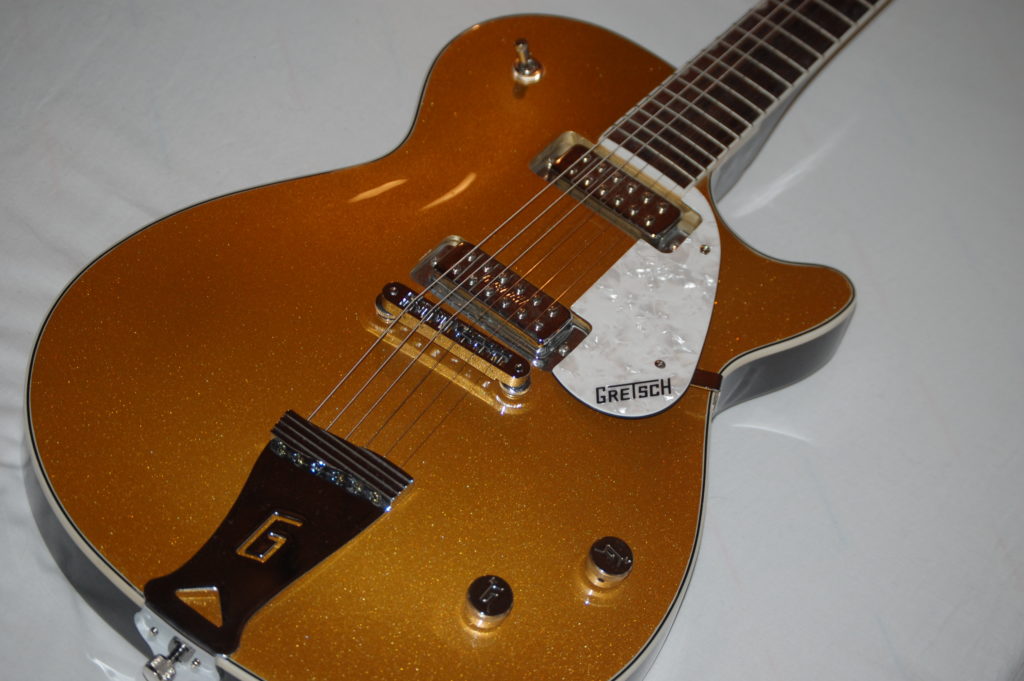
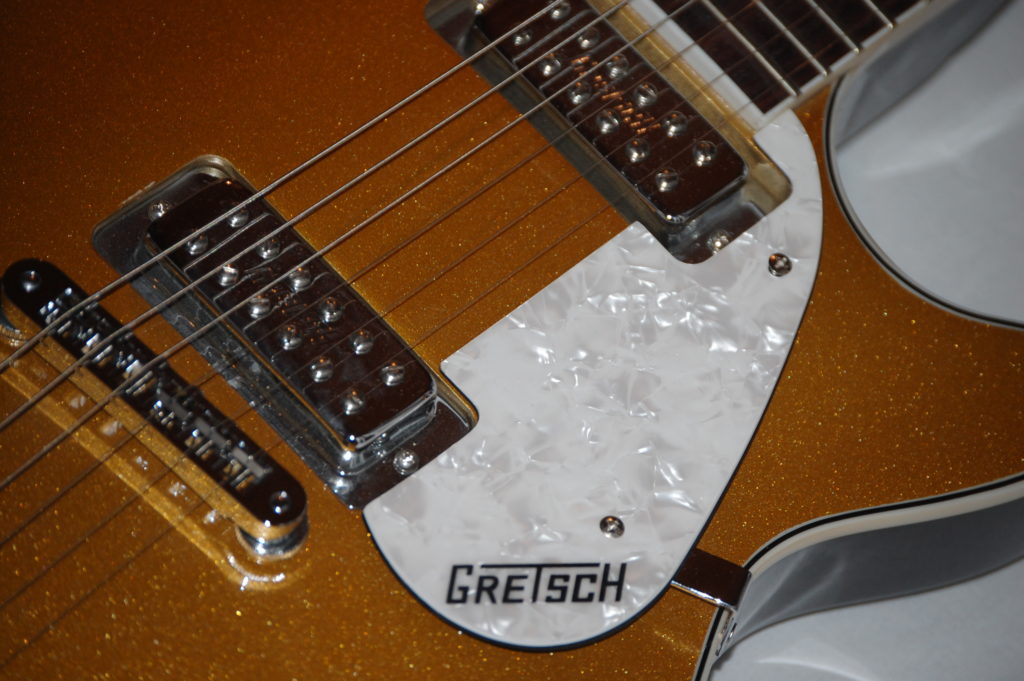
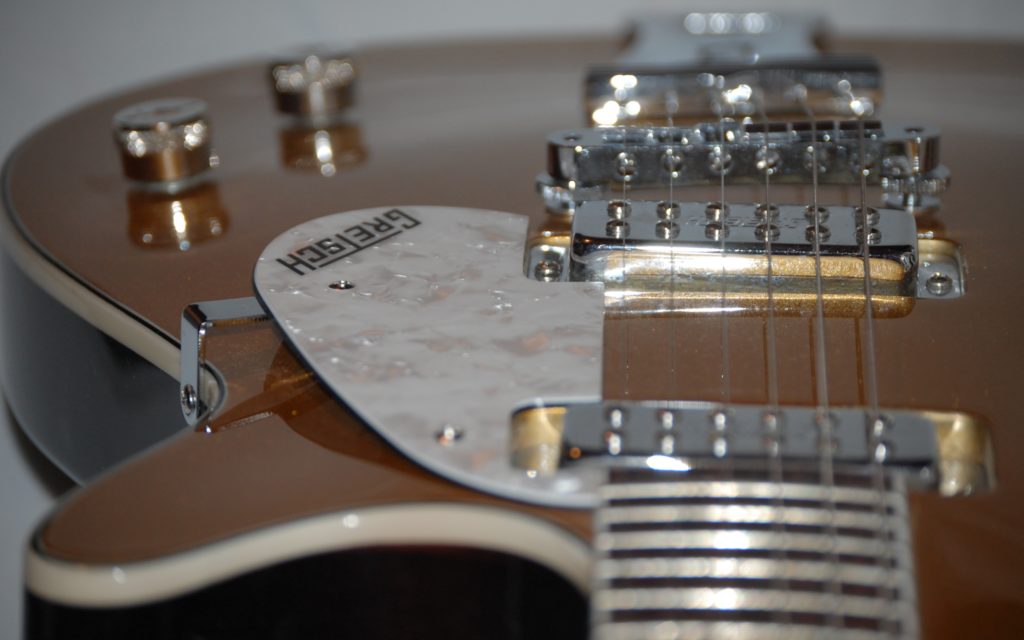
Parker P40
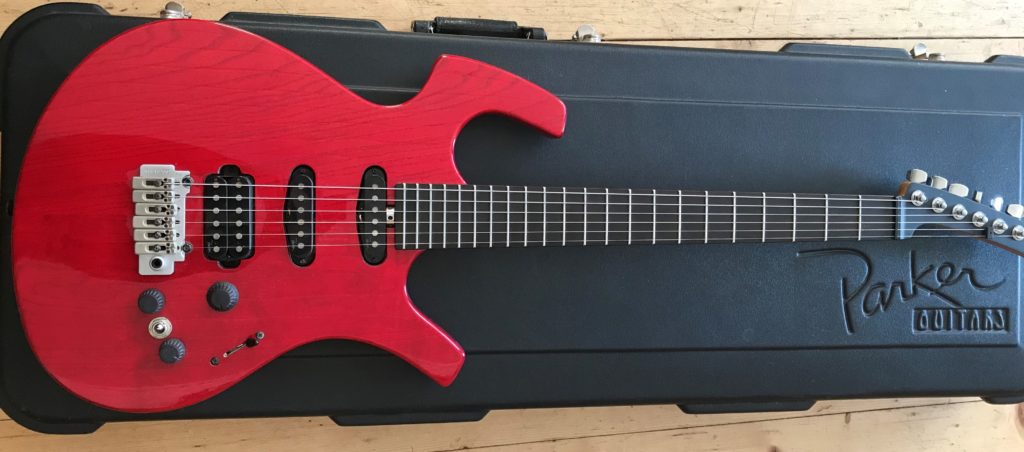
Parker P40 (2009-2021)
Bolt-on neck, HSS configuration with five-way switch, master volume and tone. Piezo in the bridge, switch for either or combination, blend control.
Guitarists are a conservative lot. At times the next great thing since sliced bread pops up – Masonite? Synth guitar? Robot tuning? Plexiglass? – but for performing the traditional F or G is donned for sheer trustworthiness.
An American inventor named Ken Parker hit something when he came up with the composite hybrid named the Fly. Piezo in the bridge and various combinations of HB and/or SC placed on a rather radically shaped body made of wood reinforced with composite materials. Where Gibson stressed the sound properties of a weighty body, Parker emphasized the lightness.
I tested a used Fly at Helland in Skien several times, and if I had had like 1400 pounds in my pocket on those occasions, I would probably have owned a Fly. I liked the shape, and I even started on a project to turn a Squier Affinity (the third to be maimed by me) into something Parker-ish.
Then I sold the Artcore, and a bombproof case containing a P40 arrived The P40 is far more traditional with a bolt-on maple neck and all-wood body, but the shape is still there. Once again there was an exhibition opening, this time also featuring my photographs, and Felix of EH Band/Trio fame and I did a couple of songs. A year later I performed at a cultural gathering with violinist Billy Lätt in Tønsberg. As the apprentices were knocking on the door, and the one-offs in the collection headed towards the exit, it was time to say goodbye to Mr. Parker in February 2021. I would have kept an original Fly, probably.
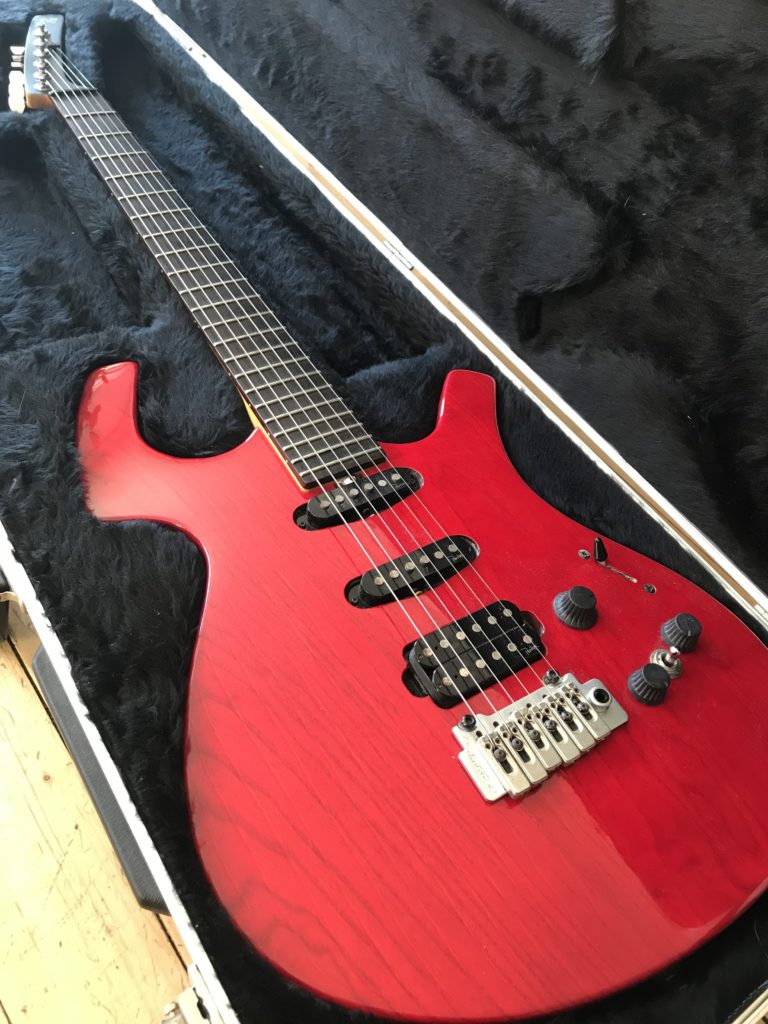
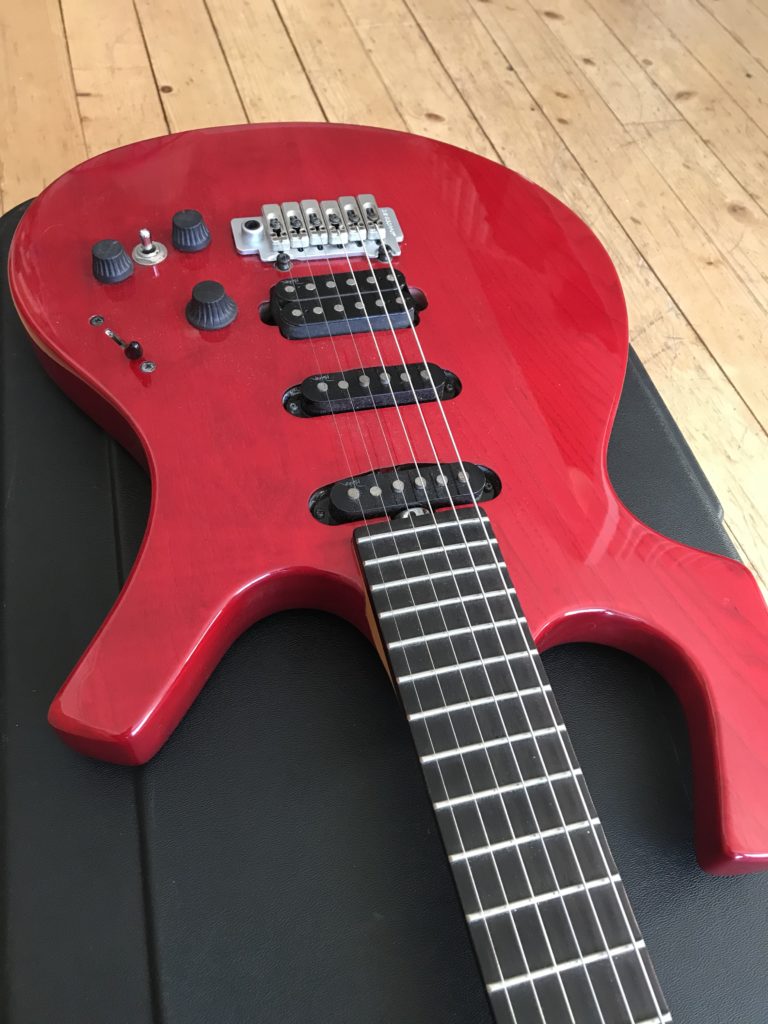


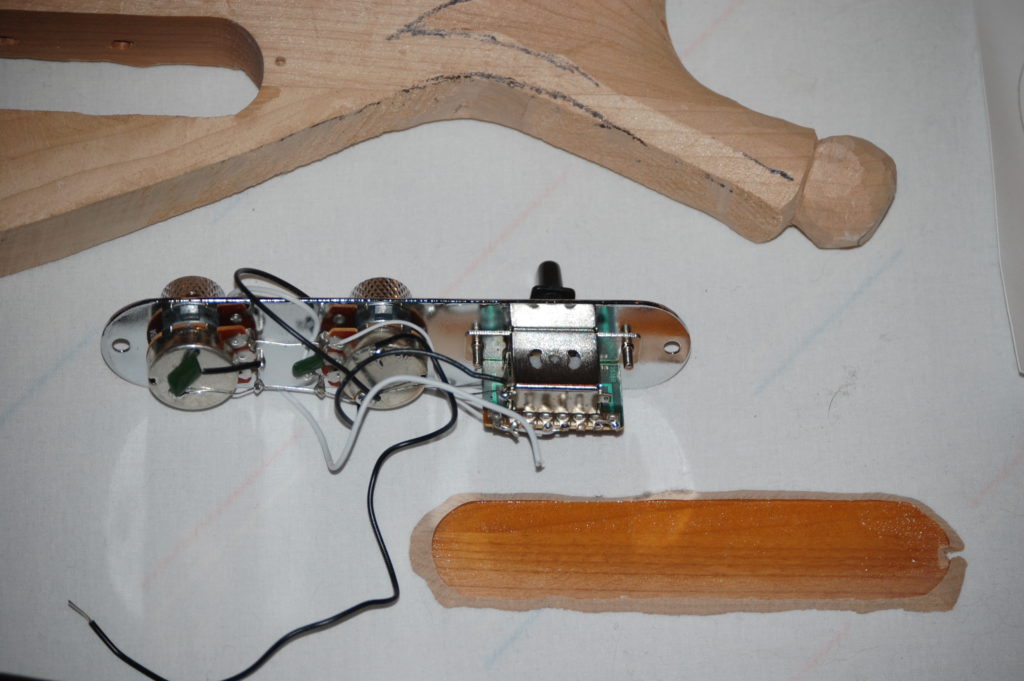
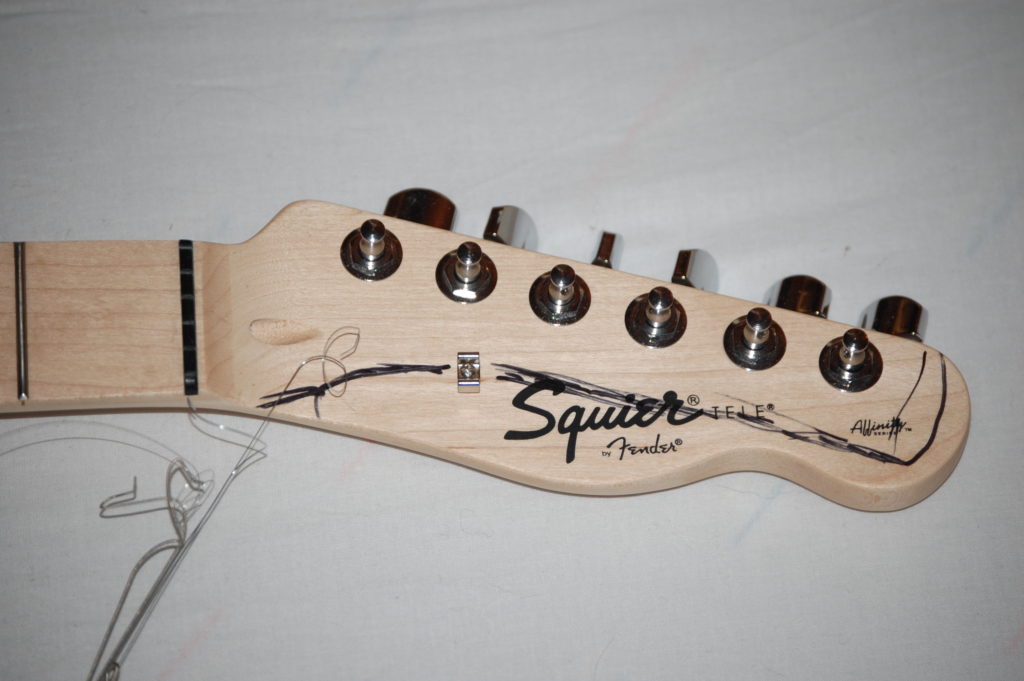
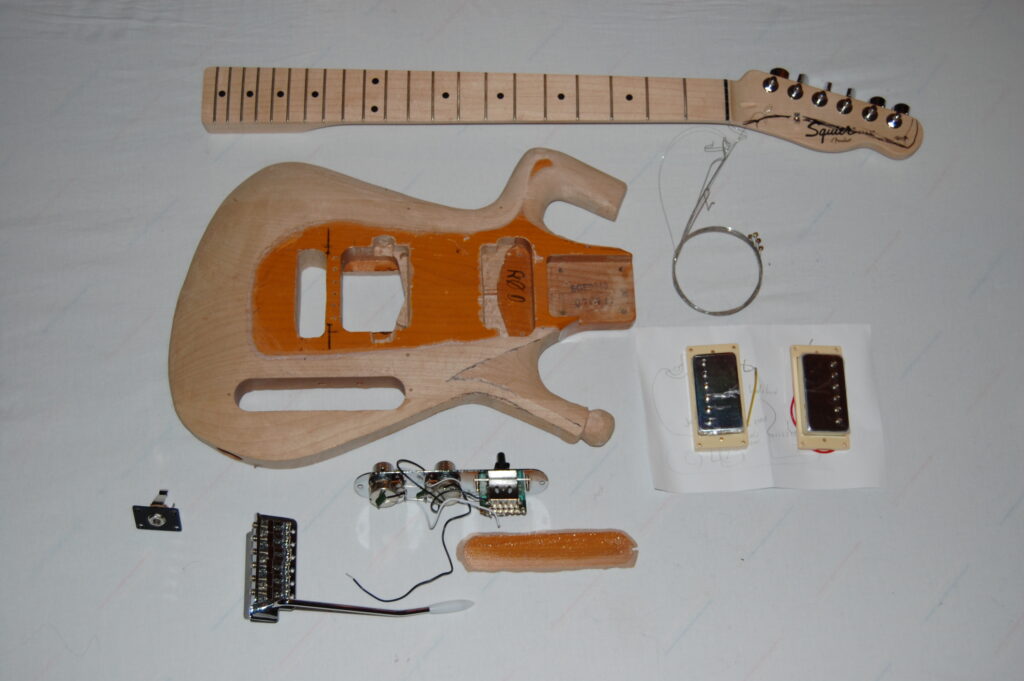
Øivin Fjeld G#

Øivin Fjeld G# 2011 (2011-2021)
One pickup, one volume. Imagine a capo on the fourth fret of an ordinary guitar; this is it. Øivin Fjeld is a Norwegian luthier who thought up this, it comes in steel and nylon versions, and several well-known guitarists have been seen with one. a-ha has been seen with two. Great build quality, it is heavy enough to inspire trust.
Bought to be taken North for a three week trip with limited luggage room in the car, along with the Zoom H4 and a desktop speaker. A fun instrument to play, although jamming with other musicians may present a challenge. OK, I’ll play an E, ohno, that’s actually a G sharp. You play an E, and I play – uh –
As much as I would want to, I can’t have it all. Fun to play, but I decided to let it go.
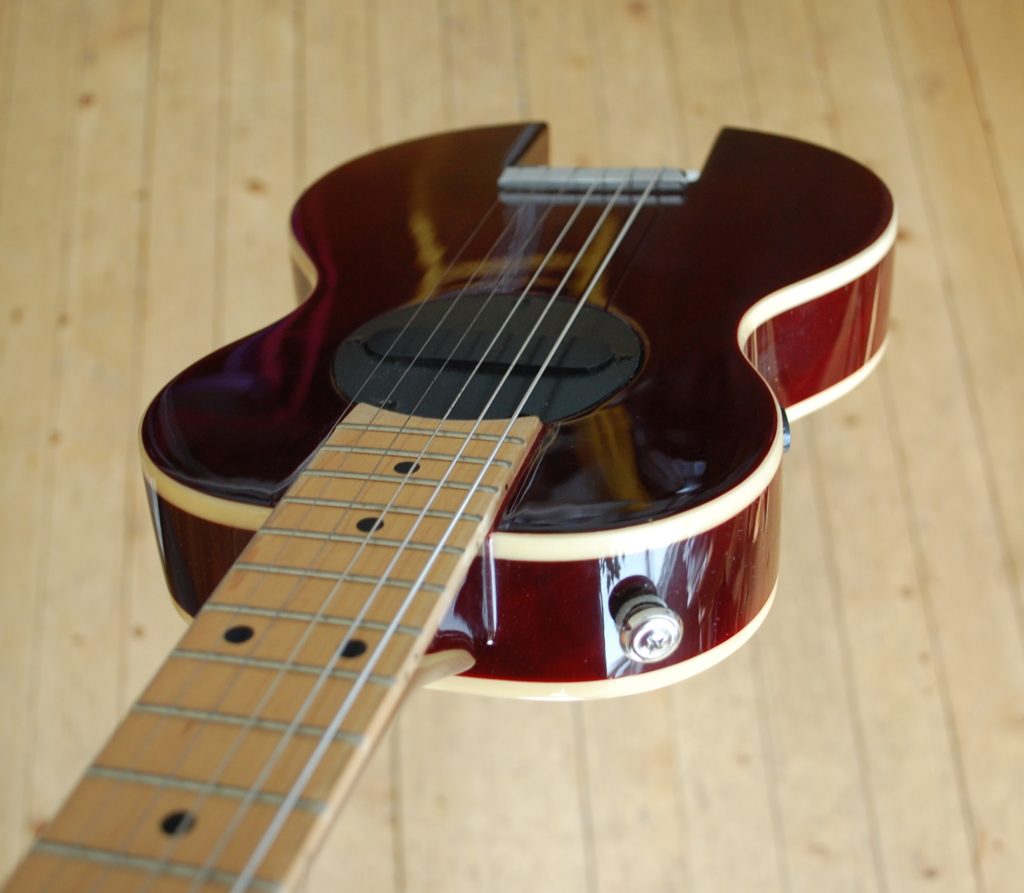
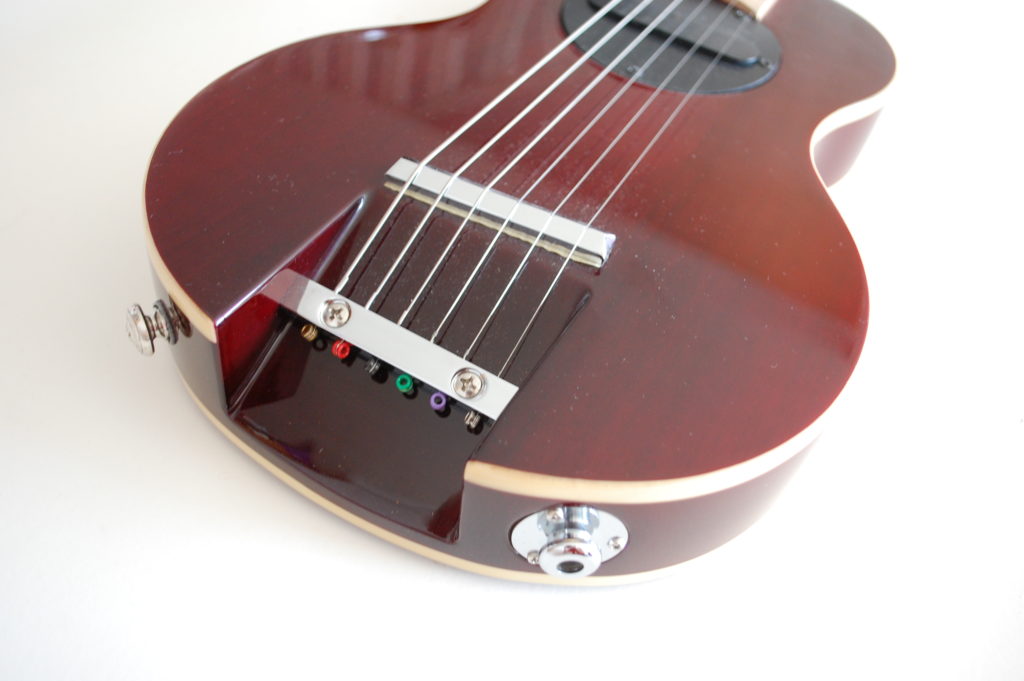
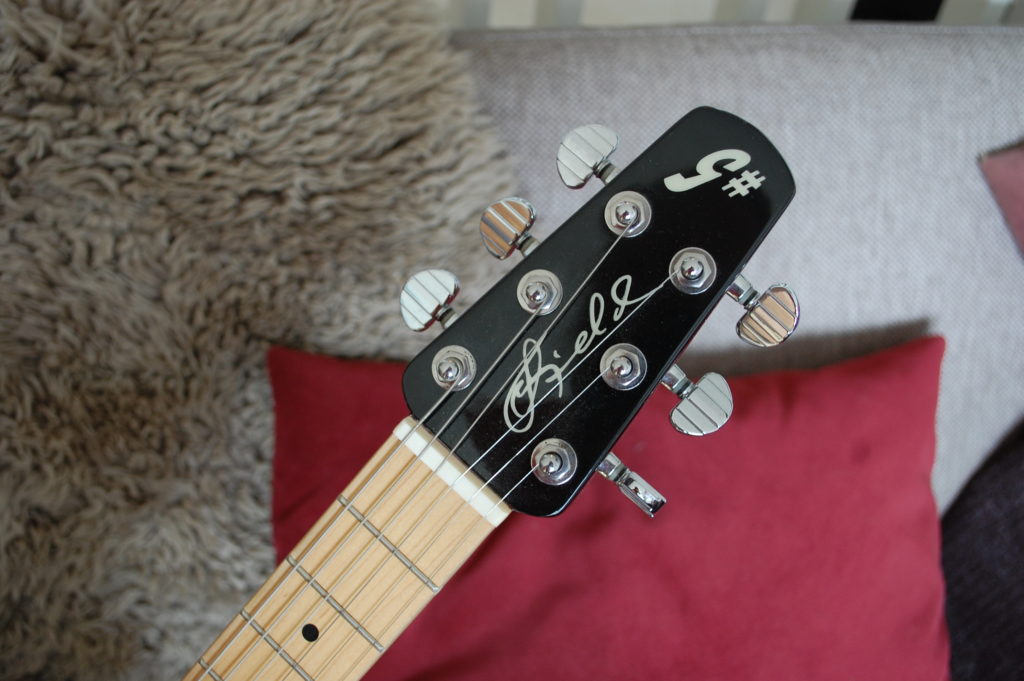
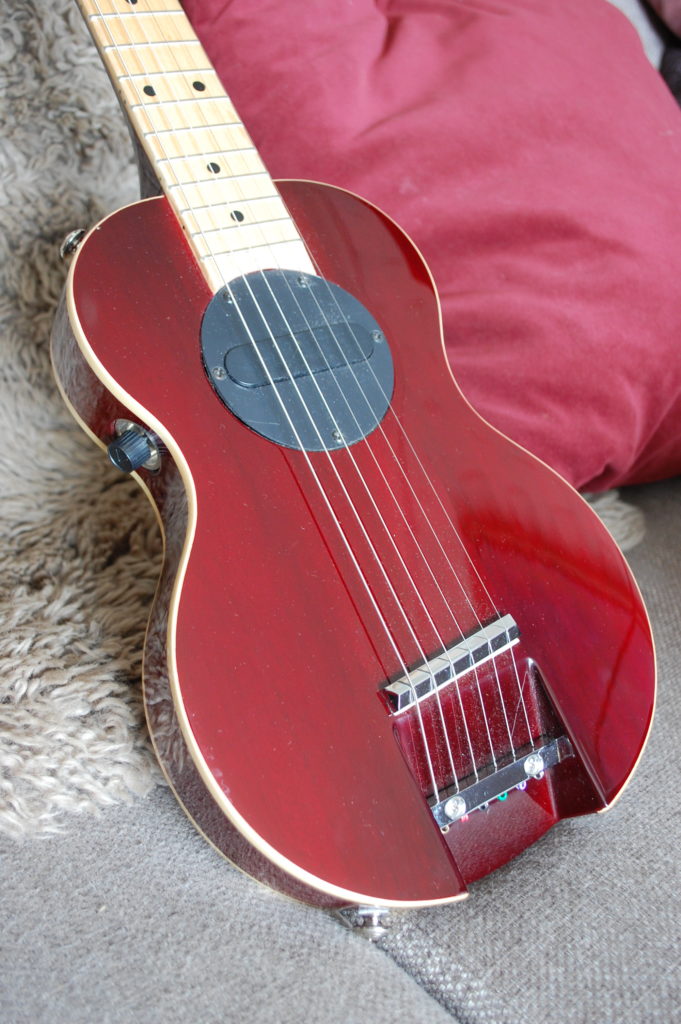
Tulip bass and guitar

Kay Tulip and Teisco EB110 Tulip bass 70s (2011-2018)
Laminated necks (two-millimetre slices), two pickups with on-off switches (guitar) and one pickup (bass), volume and tone.
Some things come in pairs, like for instance boots.
Searching for sixties or seventies instruments, these turned up on eBay. They cost, as a pair, less than a pair of leather boots.
A recurring theme with guitarists of all ages (like me; se most entries on these web pages) is “I would really like a…” While dreaming of a Jazz Bass, you could always scratch the well-known F on the bridge cover. Collections change, and one day in January 2018 I approached the nearest postal service where the pair set out on another journey, this time to Trøndelag.
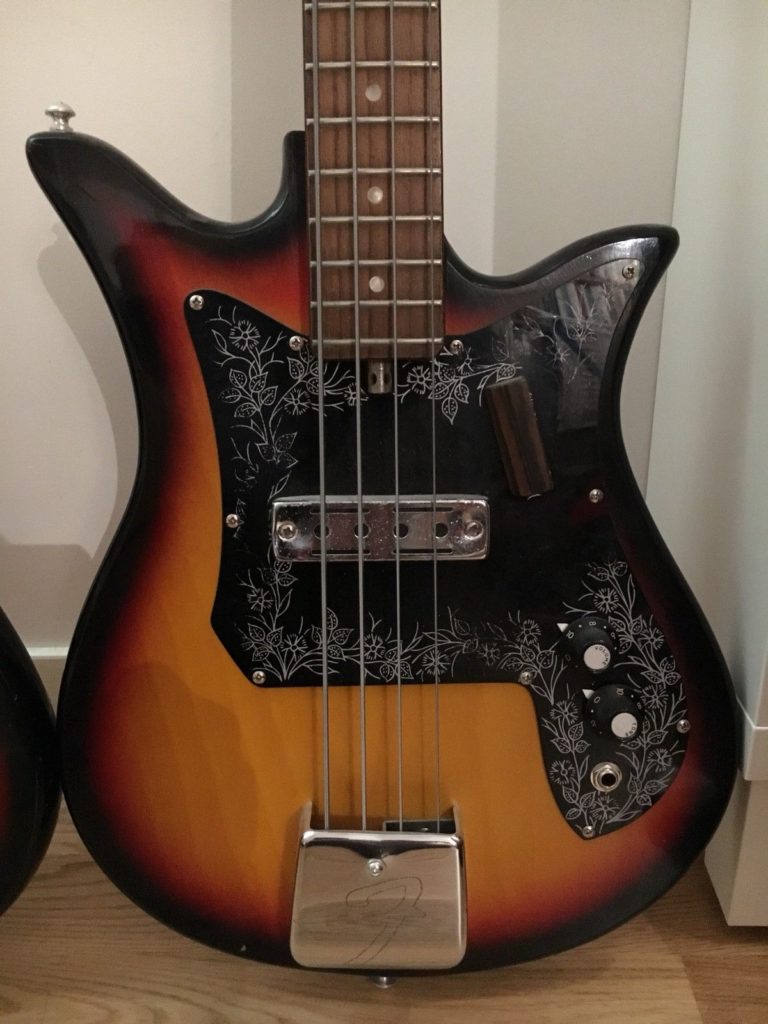
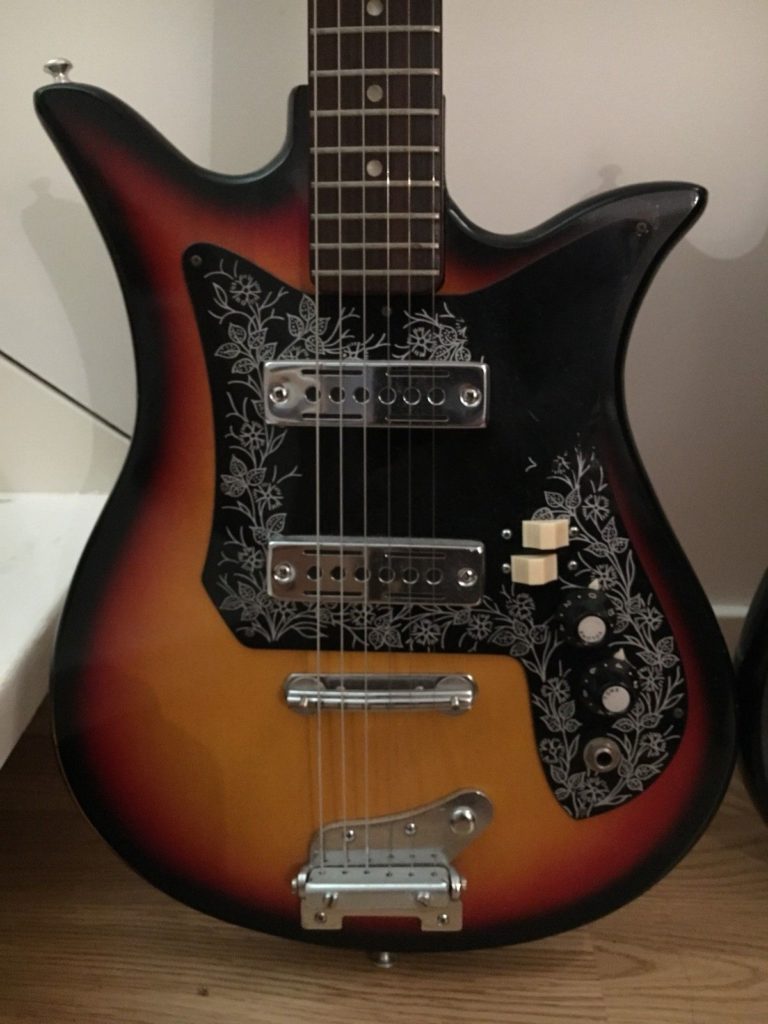
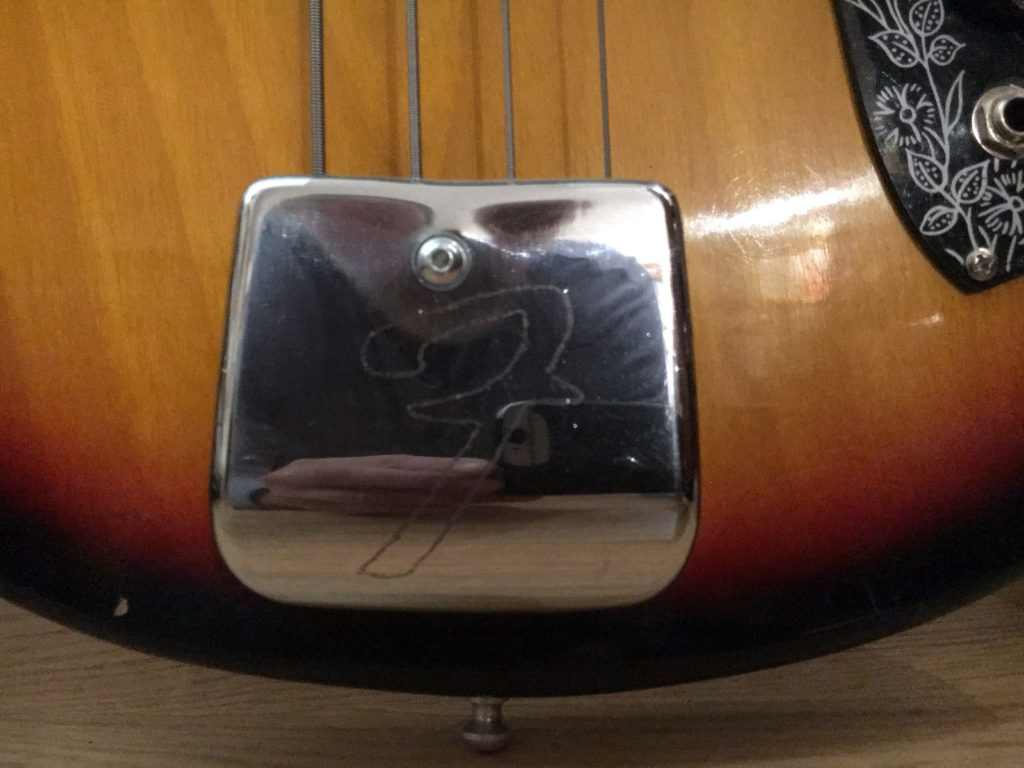
Ibanez 2020

Ibanez 2020 (2011-2019)
Early Ibanez (produced 1969-71) from the Inspired by-period, before making serious copies. Strat-like body, P90-looking pickups, master volume and tone. Three way switch and original vibrato. Some fret wear and small dings, but in great shape for a fifty-year-old. Along with the tulips and a few oddballs put up for sale; there was a young guy living close by who was interested. I brought it to his attic studio and immediately saw myself in early collection stages. It suited his hands although straining his wallet, and I had no problem lowering the price to let him have it.
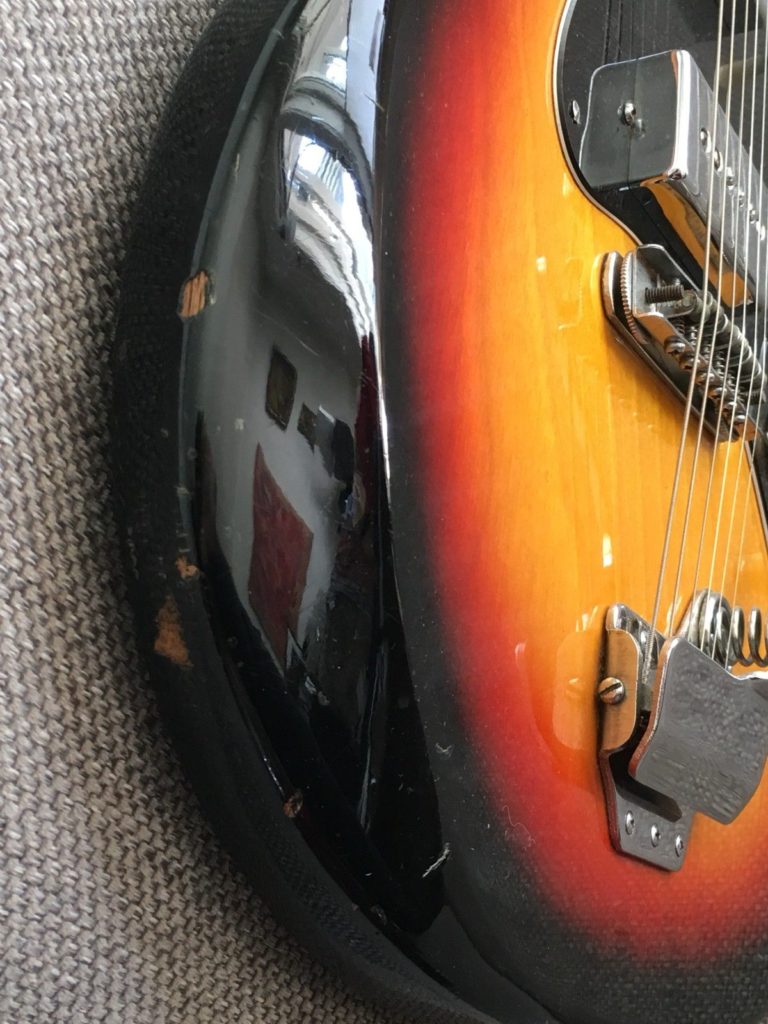
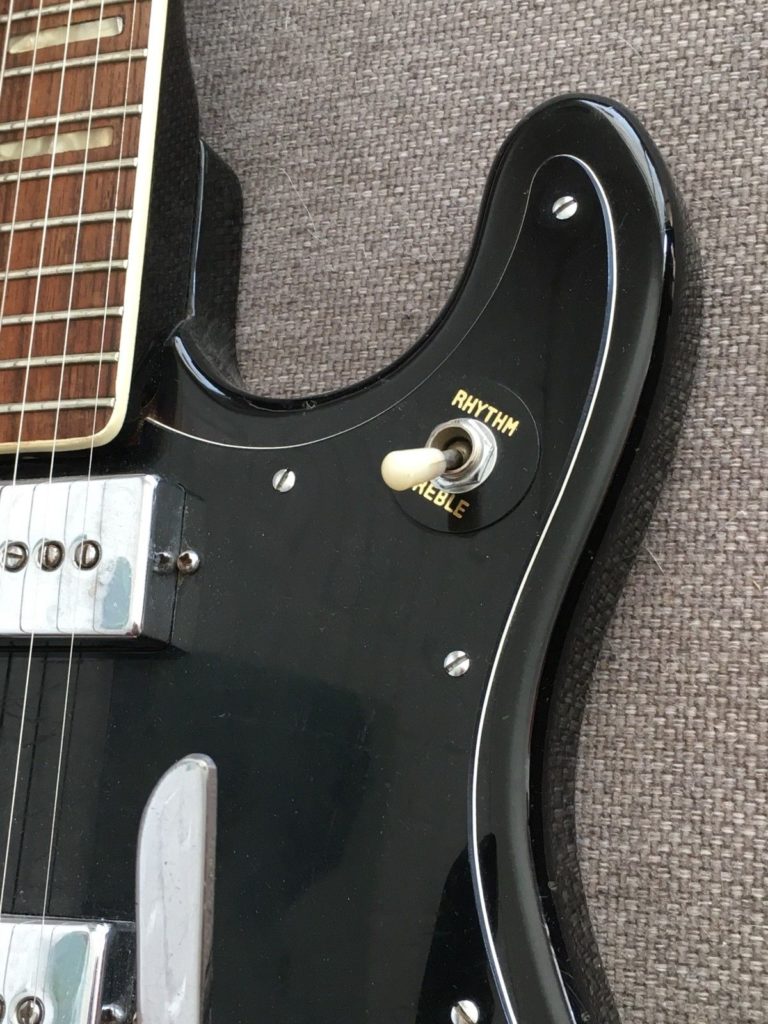
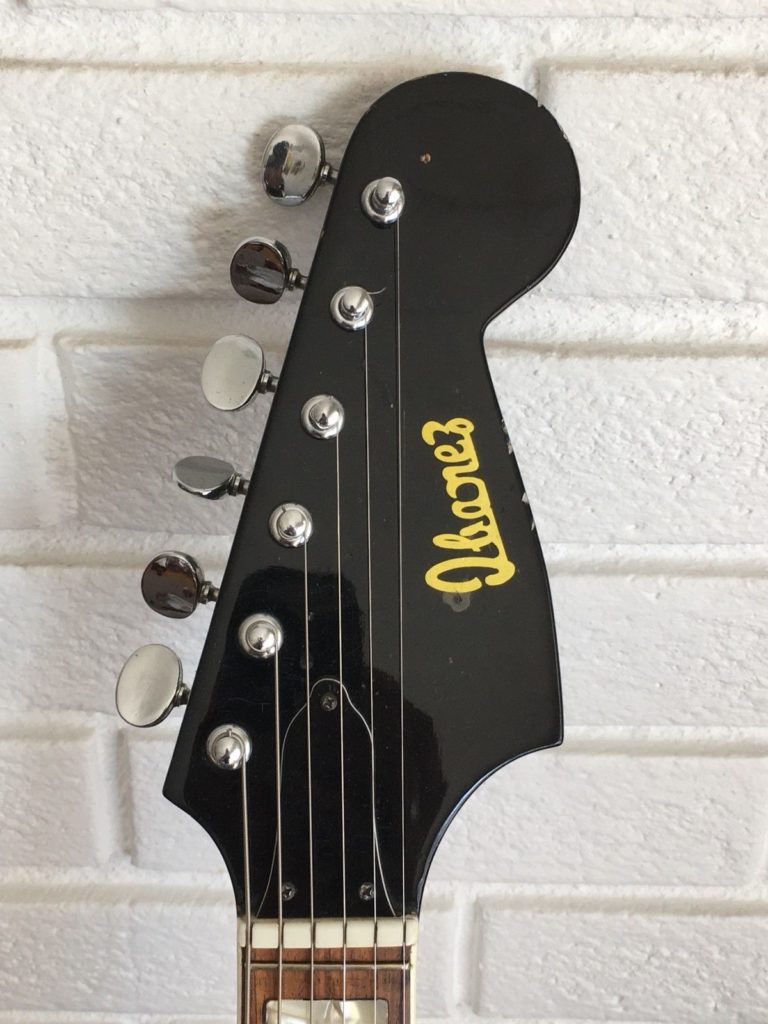
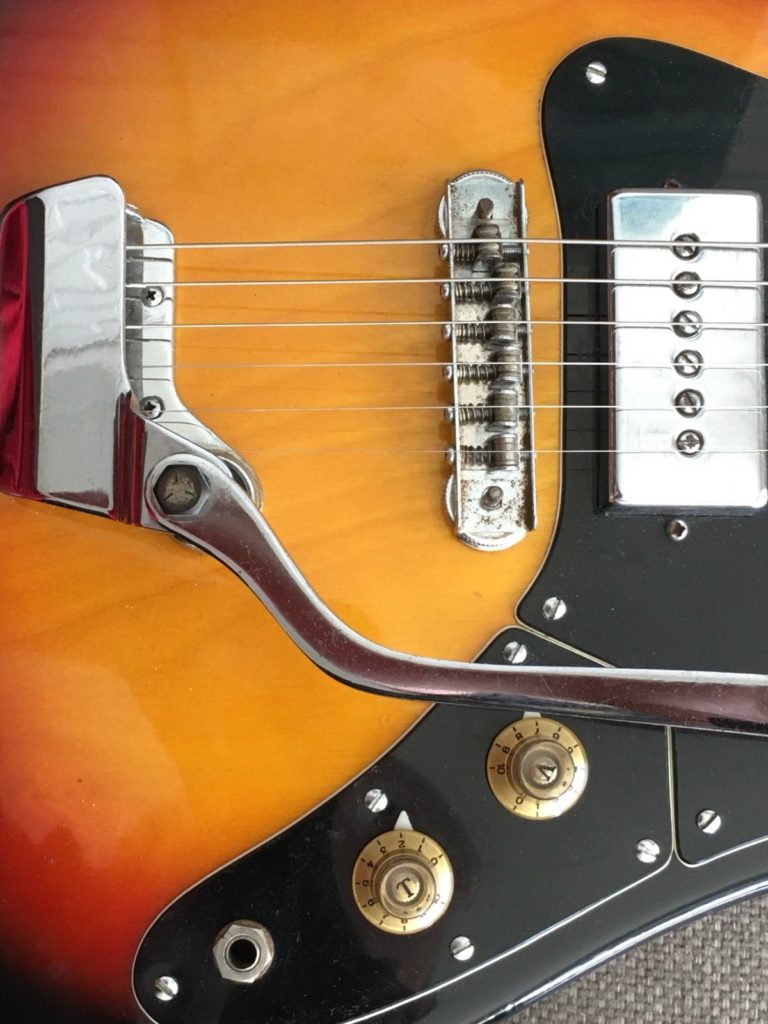
Gibson Les Paul Junior


Gibson LP100 Junior 2015 (2015-2017)

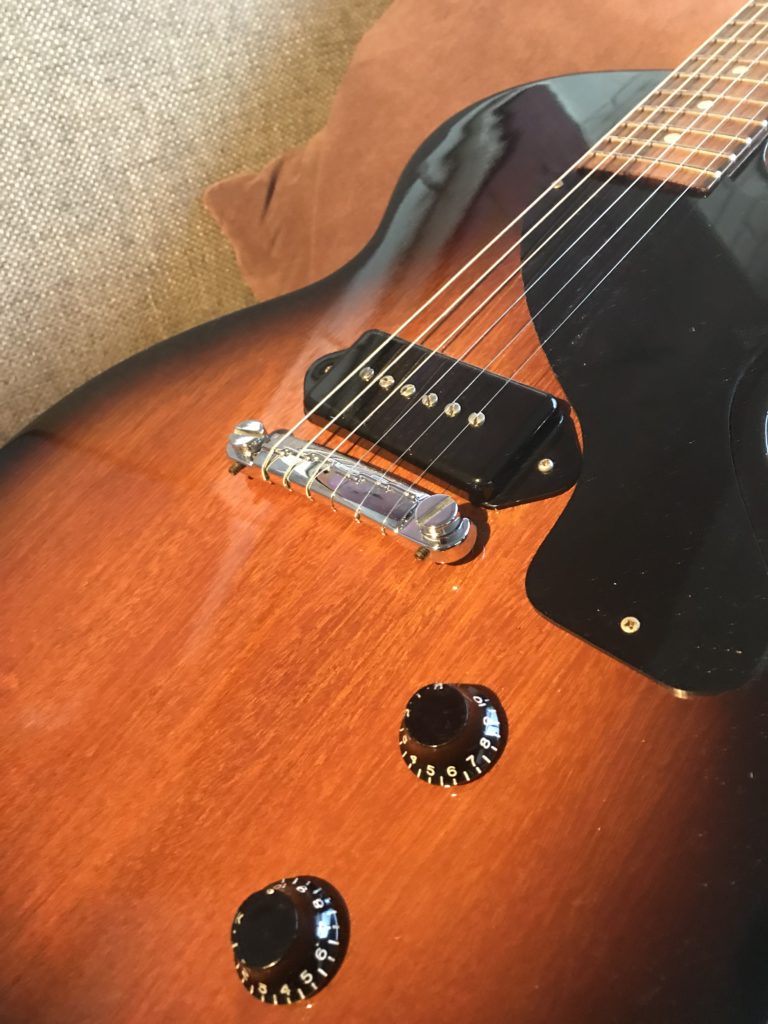
Gibson Les Paul Junior 2011 (2017-2021)
The Junior is Gibson’s student model from 1954, made to supplement the line of Les Pauls establishing the Custom at the top, then the Standard, the Special, and the new one-pickup Junior as entry level. Discontinued in 1963, reintroduced in 2001.
This is a story in itself, with a rather unexpected outcome. I knew Steve Howe used a Junior recording the bulk of Tales from Topographic Oceans, one of my favourite Yes albums. I have seen them play the 26-minute Ritual live three times, featuring Steve and his Junior. High on my wish list. In 2015 I found the opportunity to add a brand new Junior to my own LP family of Special, Standard and Recording.
Great disappointment. I didn’t like the Les Paul 100 logo, the nut was brass, the sunburst wasn’t yellow enough, and it didn’t sound like Steve Howe. I sold it two years later, and immediately got a 2011 at twice the cost of the 2015. It was OK, and I really tried to like it. Plugged it in and told myself we needed some time together.
Then, in early 2021, I saw this copy on eBay. It had a Gibson logo, but the seller was totally clear that was a scratchable decal. It had a Bigsby, but nevermind, I wanted it. The seller nearly changed his mind citing bad experiences with eBay, but I was relentlessly persuasive and we made a deal.
The «Junior» and I clicked immediately. Frankly, I have never felt this responsiveness in any guitar ever. Raw power and no frills, turn up the volume and tone and just play.
Within hours I had put the second Gibson up for sale.
MIJ “LP”
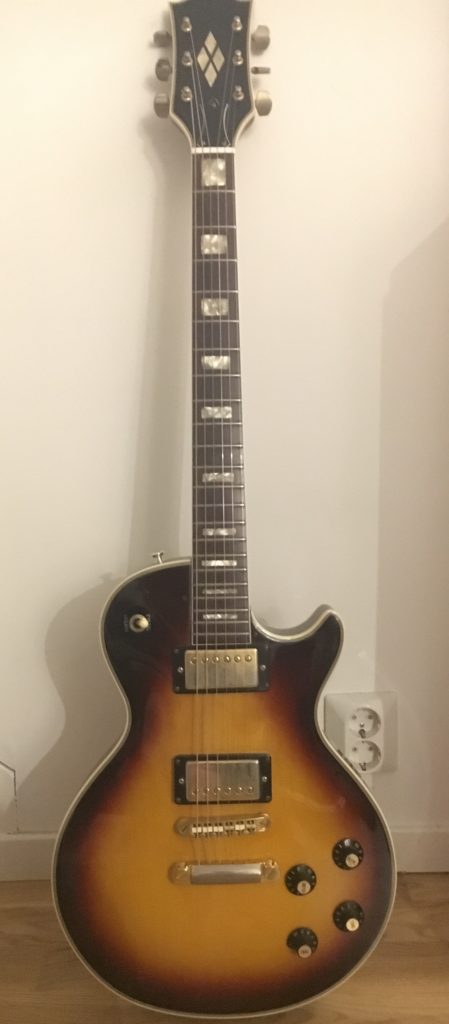
MIJ «LP» (2018-2020)
Standard Japanese bolt-on LP type. No name on the headstock, theories say Hondo or Hohner. I was a little quick there; the guitar is nice, but did not conform to my strict headstock rule.
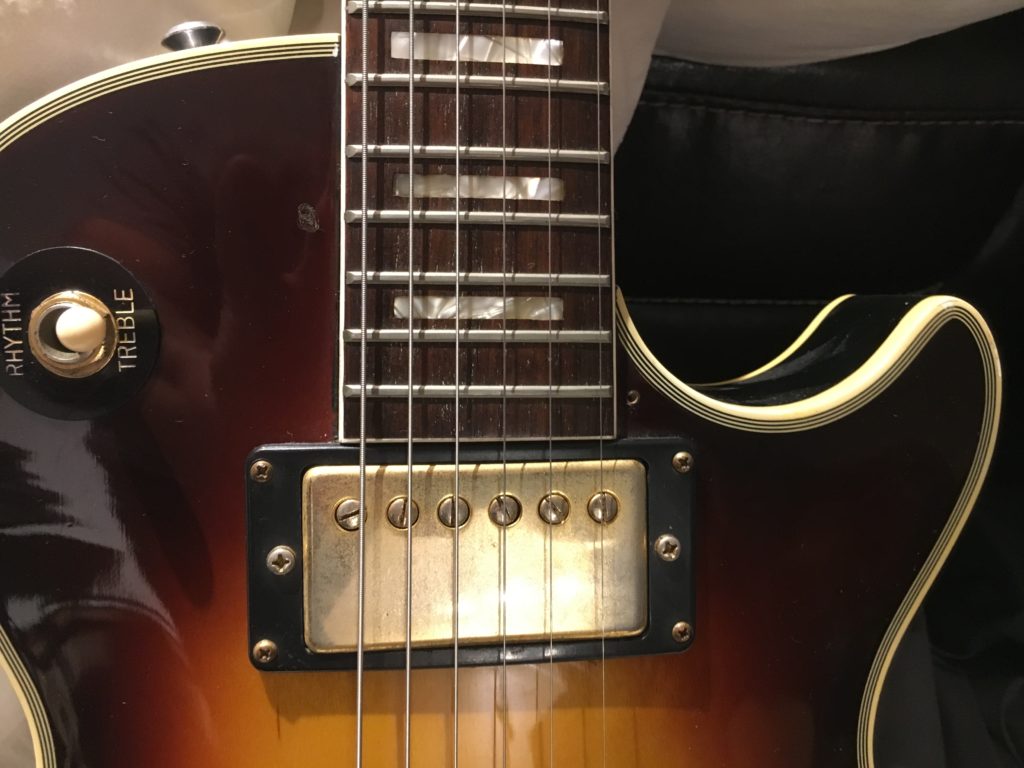
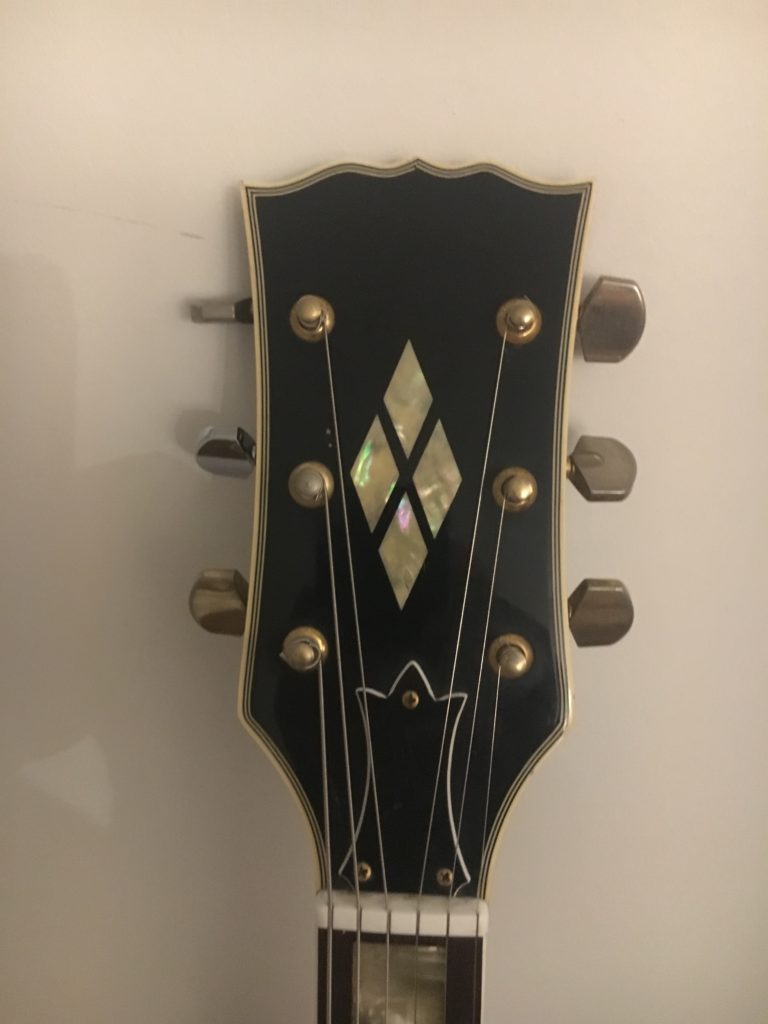
Fender Sonoran
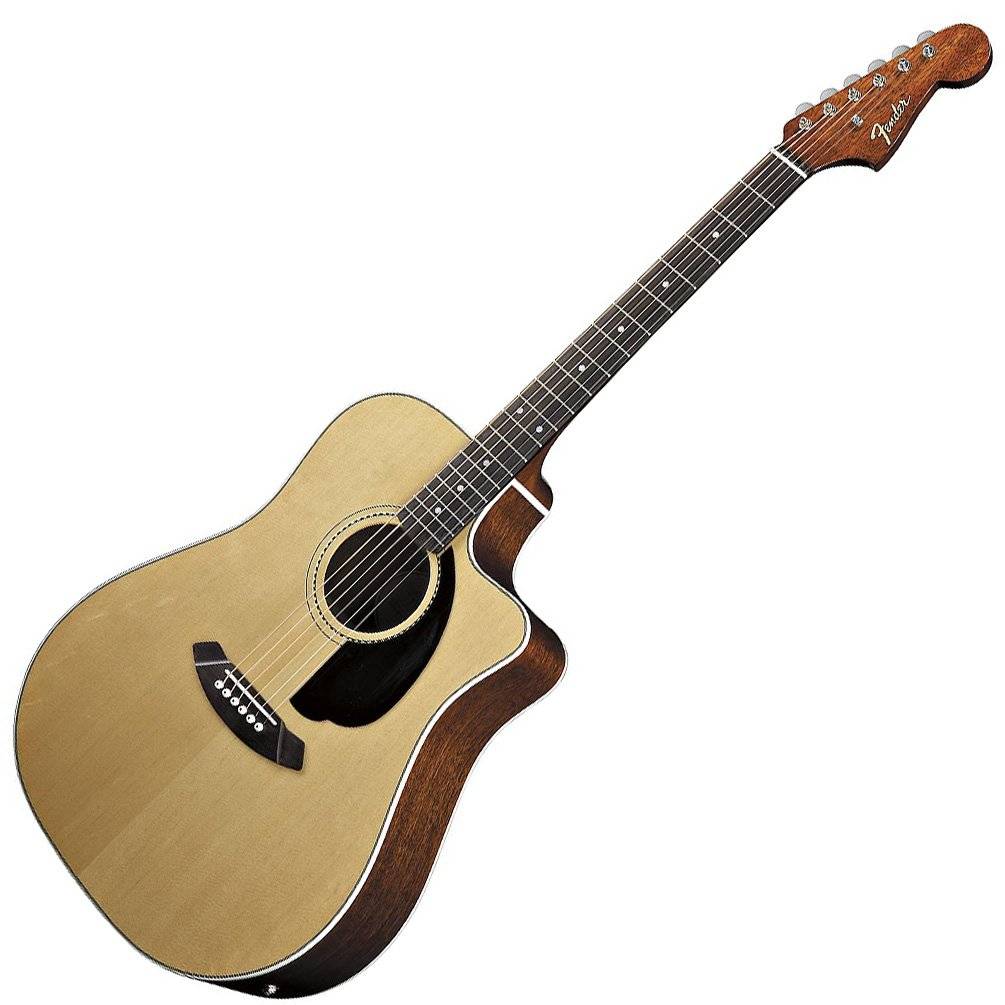
Fender Sonoran (2018-2018)
Holds the record for the shortest stay in the family. Traded it for the Yamaha, then sold it on after mere weeks. Great sound, great action, but I never liked the shape. The Ibanez Masa can never be replaced anyway. Photo from the web as I didn’t bother getting the camera out.
Jacob Knudsen Harmonium
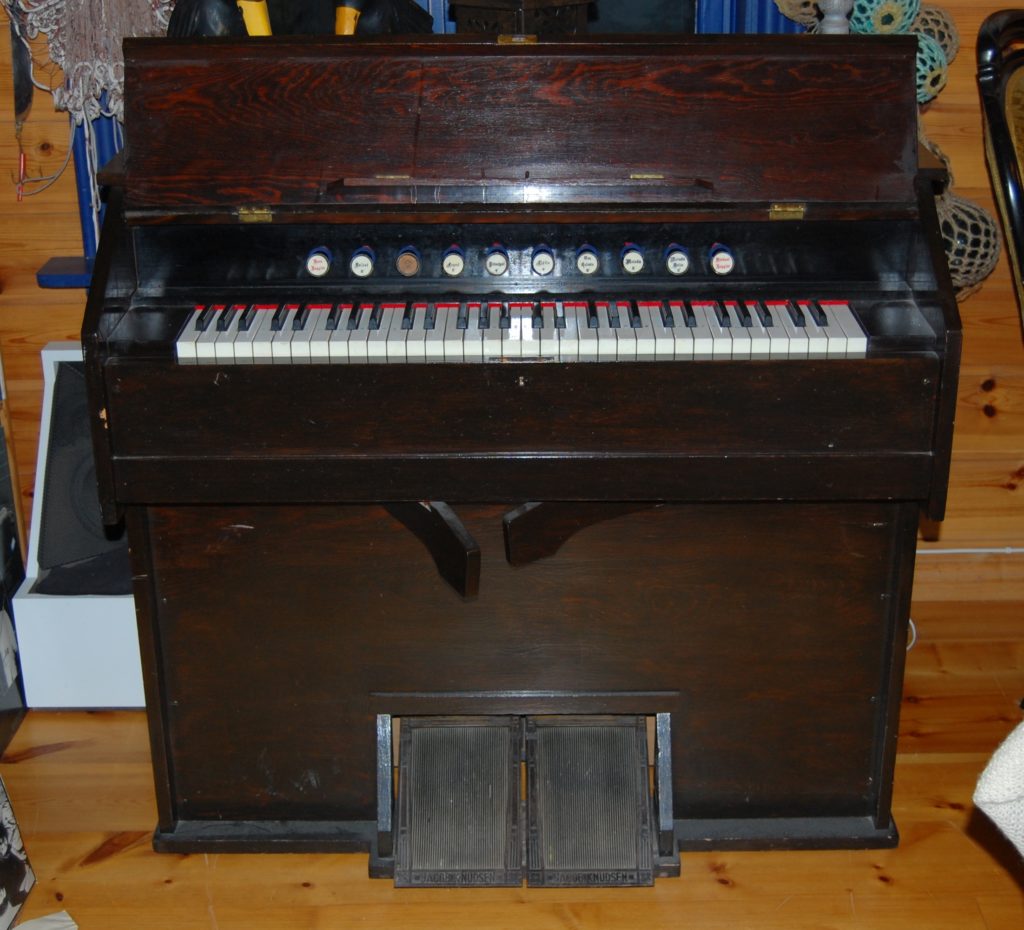
Jacob Knudsen pump organ (2006-2015)
Free-reed chapel harmonium with ten stops and knee levers for volume. Widely used in small religious gatherings from the 19th century onward.
Jacob Knudsen built more than 6000 harmoniums in Bergen between 1917 and 1966.
I feel rather bad about this one. It was condemnated in the process of moving house in 2015; there was absolutely no room for it in my residence. Its story proves that the market for these is nonexistent, and I would not want to sell something that wasn’t fully working. Some day I’ll find a new one.
Our neighbours above at Sletteløkka, that is before 1967, had one. I found the mixture of mechanics and music fascinating, and was lucky to discover one hidden away at the folk high scool in Grong ten years later, when I had more musical experience and could actually play some ambient music on it.
We arrived a little late at the annual flea market at Helle in 2006. I saw this harmonium, and waited for it to come up at the auction. It turned out nobody had bid on it. What would this be worth? £100? 150? Lead me into temptation, I can manage that. I checked keys and stops, most of it functioning. The auctioneer approached. «Interested? Will you give £25?»
Keep your face straight, Erik, «Uh, okay.»
Three years later I passed on another that received no bids.
But then came the fateful day in 2015. I told myself that if I hadn’t paid the £25 it would not have had the nine years of extra life in our living room next to the Les Paul Standard. I watched the van drive off, remembering that the first thing I played on it magically turned into Silent Night as if my fingers worked automatically in sync with the music played on it through the years.
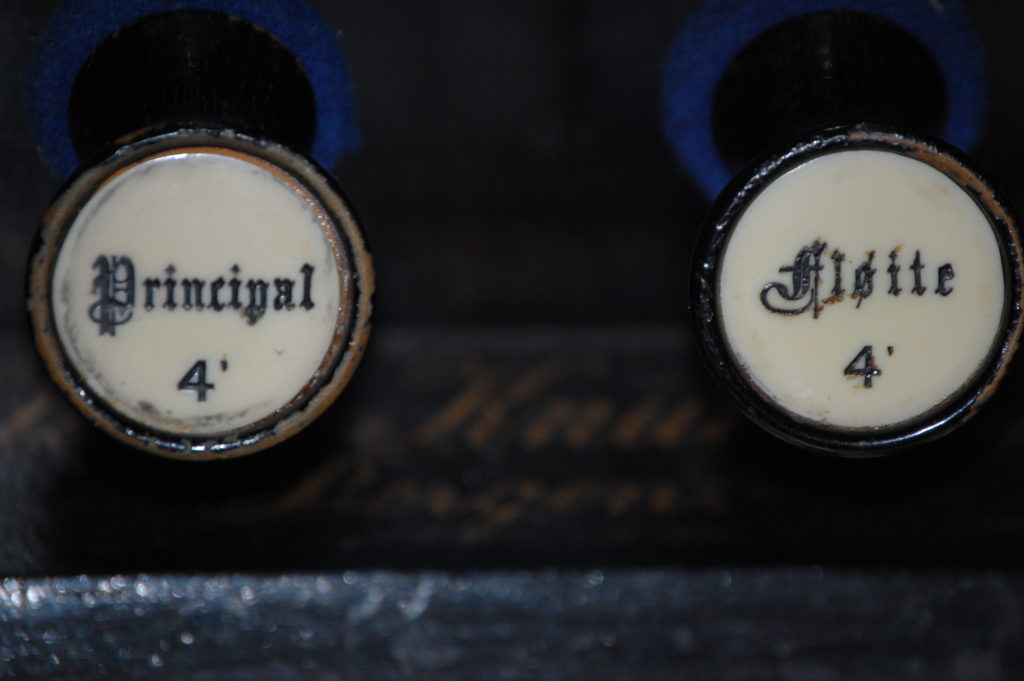
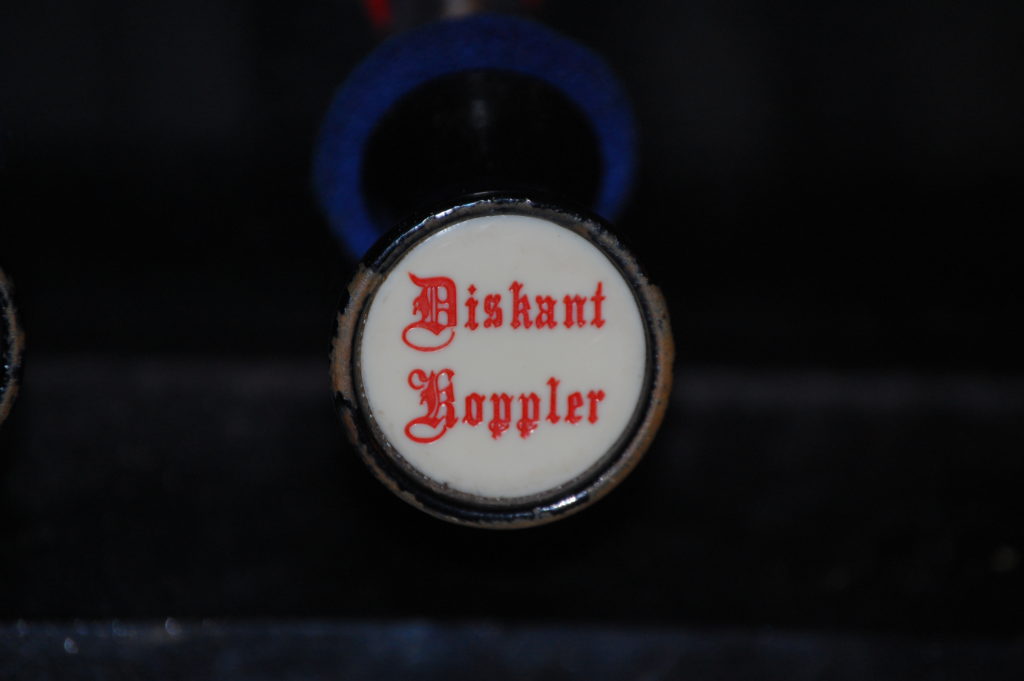

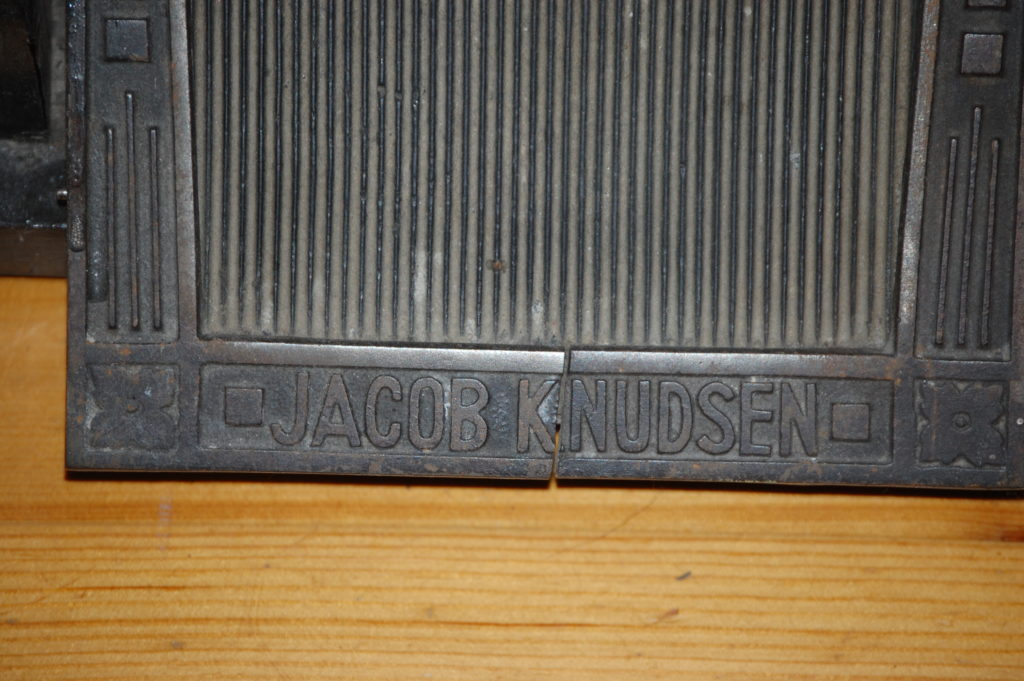
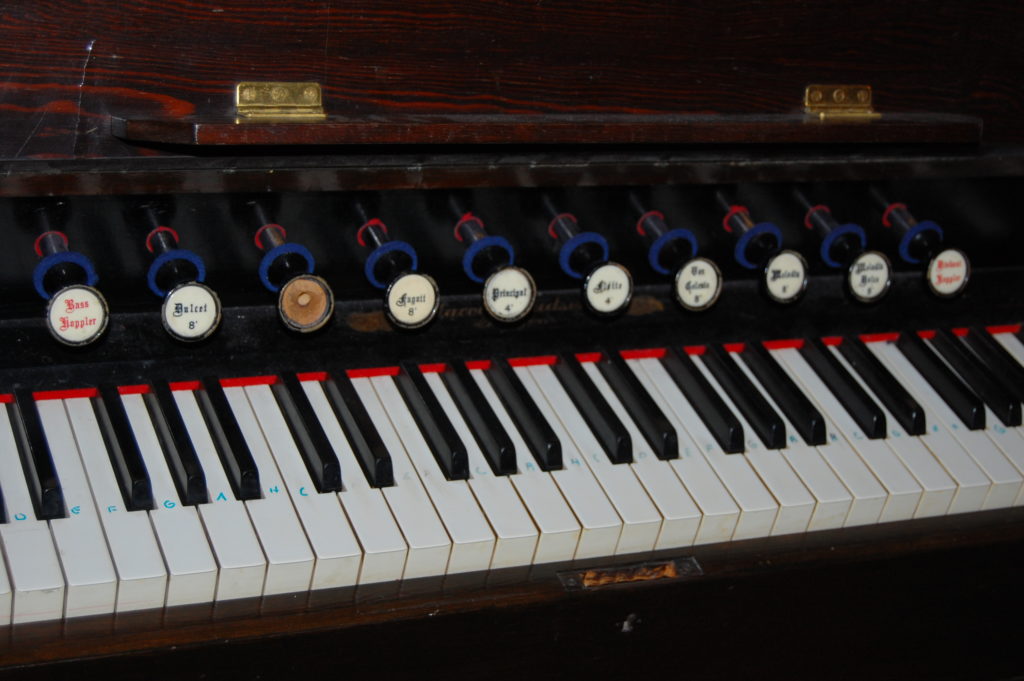
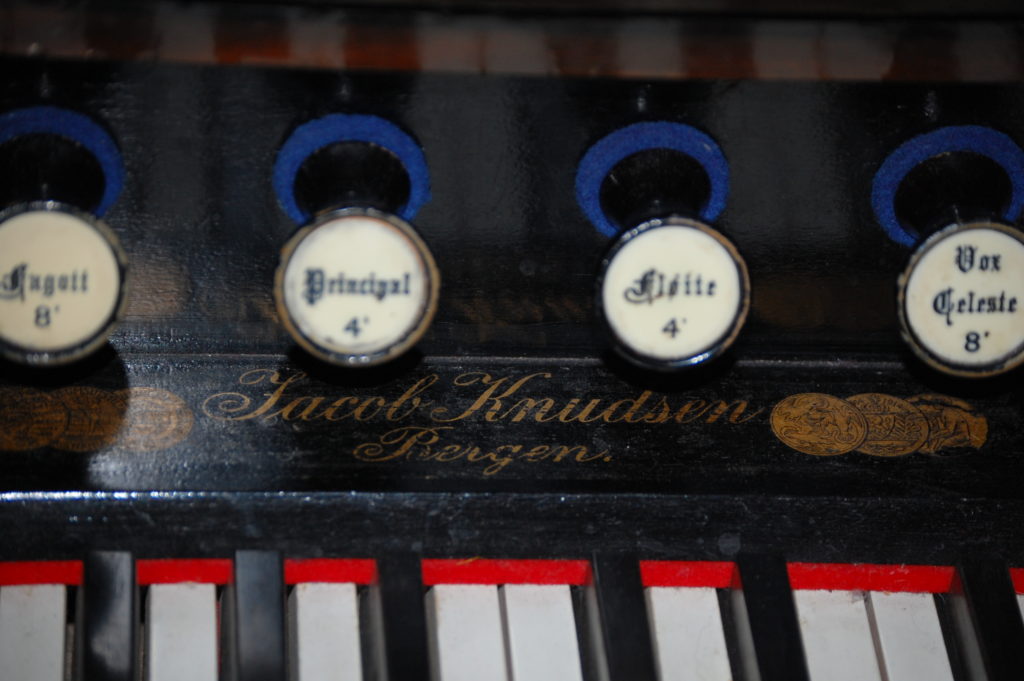
Gibson Les Paul Goldtop
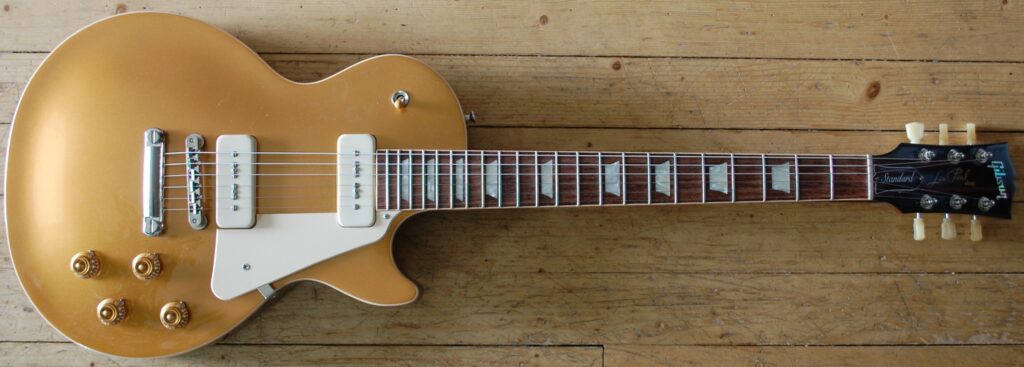
Gibson Les Paul Goldtop 2019 (2019)
1956 specs; that is new Tune-o-Matic bridge, keeping the P90s, preceding the ’57 with ‘buckers and, the year after, the fabled Sunbursts.
Been on my wish list more or less since I played Odd Arne’s in 1973. His had the mini humbuckers; somehow I feel I wanted the P90s more after gaining some experience with Les Pauls. I do not rule out getting a Deluxe when the time is right, though.
It is a strange world when the least expensive American guitar is found in Germany. That is globalization for you. Well wrapped, reasonable shipping cost, arrived on time. Weighs a bunch just as expected, and plays beautifully. There is something about the solid compactness of these maple-capped mahogany slabs (although you don’t see any maple) that oozes quality and seriousness. At times it is hard to decide which one of the Goldtop or the Standard is the most Les-ish of them.
(Earlier that year I tried a 1954, in Stockholm. Unfortunately I got no chance of plugging in as this guy had decided to test a number of drum kits in the shop. The unplugged feel, however, seemed to justify the £20.000 price tag alone.)
Sadly, this otherwise great instrument did not get played enough. I put it up for sale, and within minutes had made a deal involving a Vox AC30 – as I had relocated to a place where there are no potentially complaining neighbours.
I am still looking for a Goldtop, though. Hopefully a seventies model comes along.
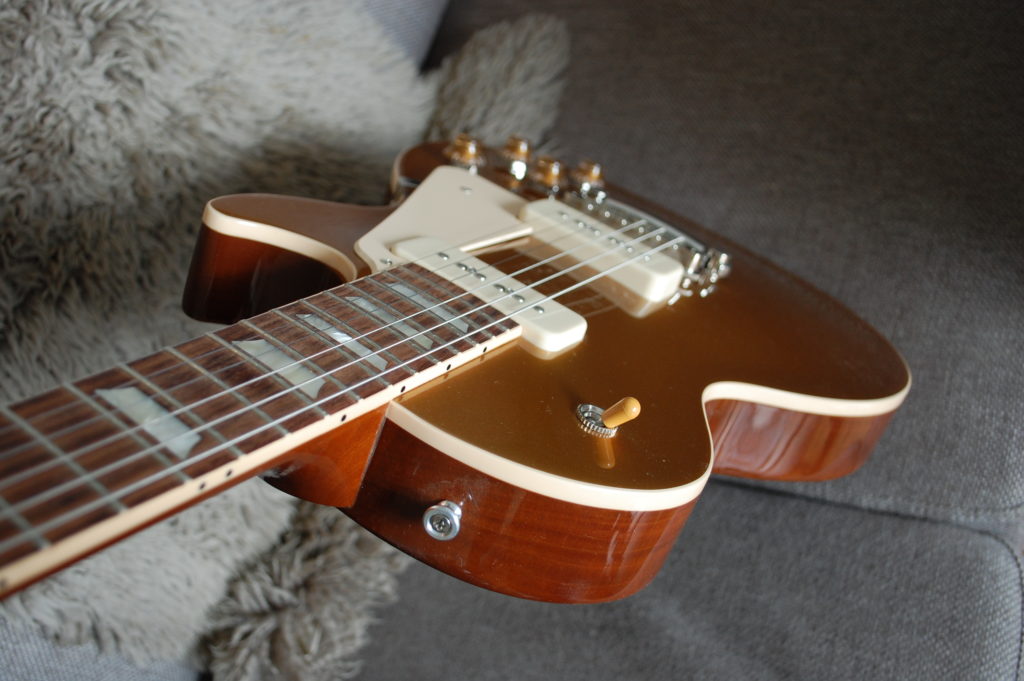

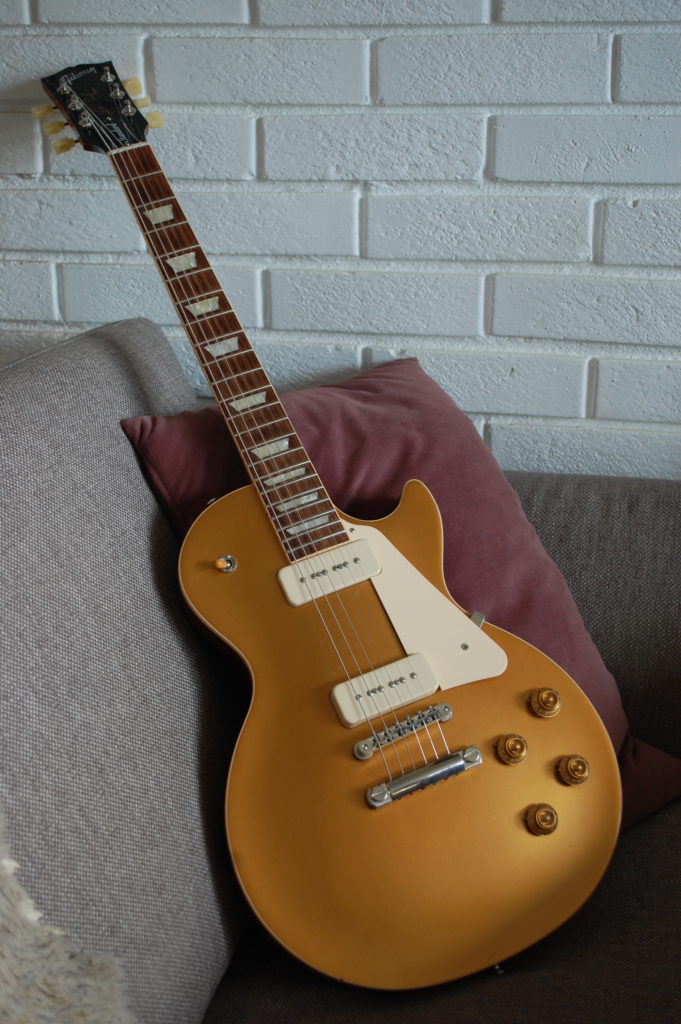

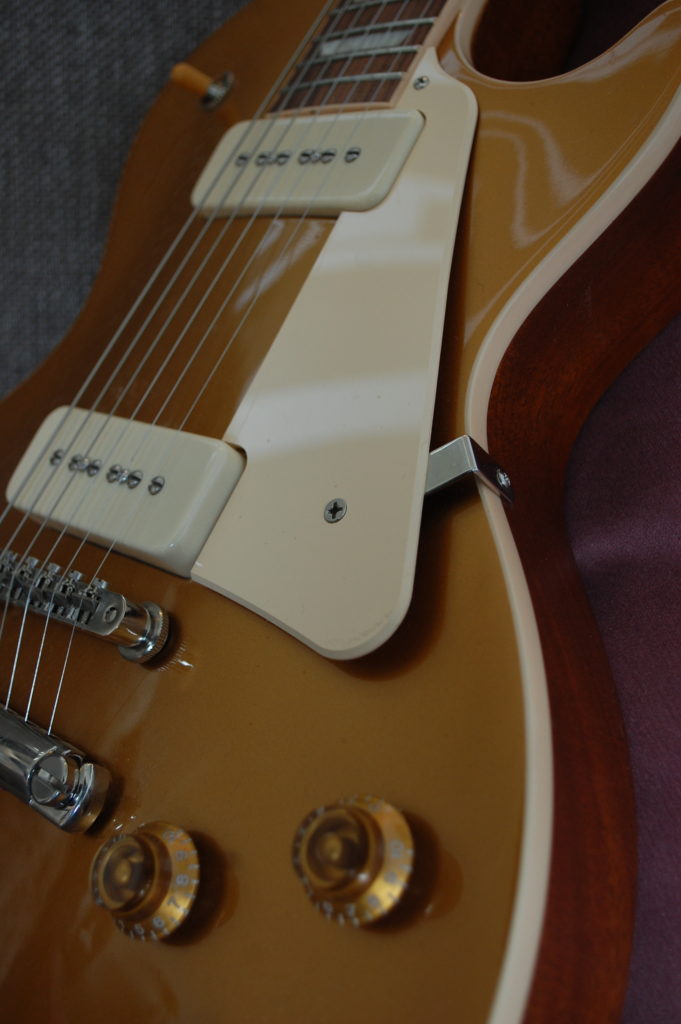

Fender Player Telecaster
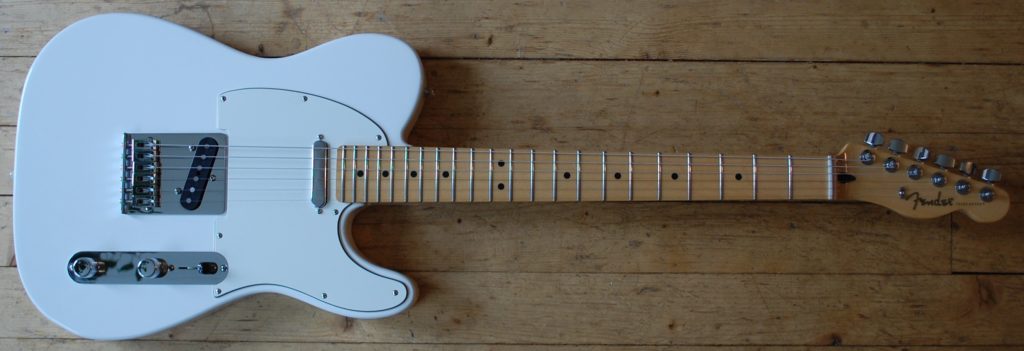
Fender Player Telecaster 2021 (2021-2023)
The new basic Mexican model with one-piece maple neck, classic pickup configuration, and modern individually adjustable saddles. Very well received by the mags I subscribe to, and I tend to agree.
This is the sixth Tele to join the family, and in a way it is the return to the original after some detours. Three Squiers have undergone drastic surgery; one of them sold, and one may not recover. I have a Squier HS that’s a joy to handle and play (for a collector, «handle» is right up there with «play») and a Fender Thinline with humbuckers that’s hard to put down. This Player is close to Leo’s original specs as well as reminding me of dream items that kept me gawking in my favourite shops in the early seventies. It has to be white, too.
It looks blue in the photos; seems I’ll have to upgrade my knowledge of lighting.
Good as it is, I decided to help it find a new home two years later.
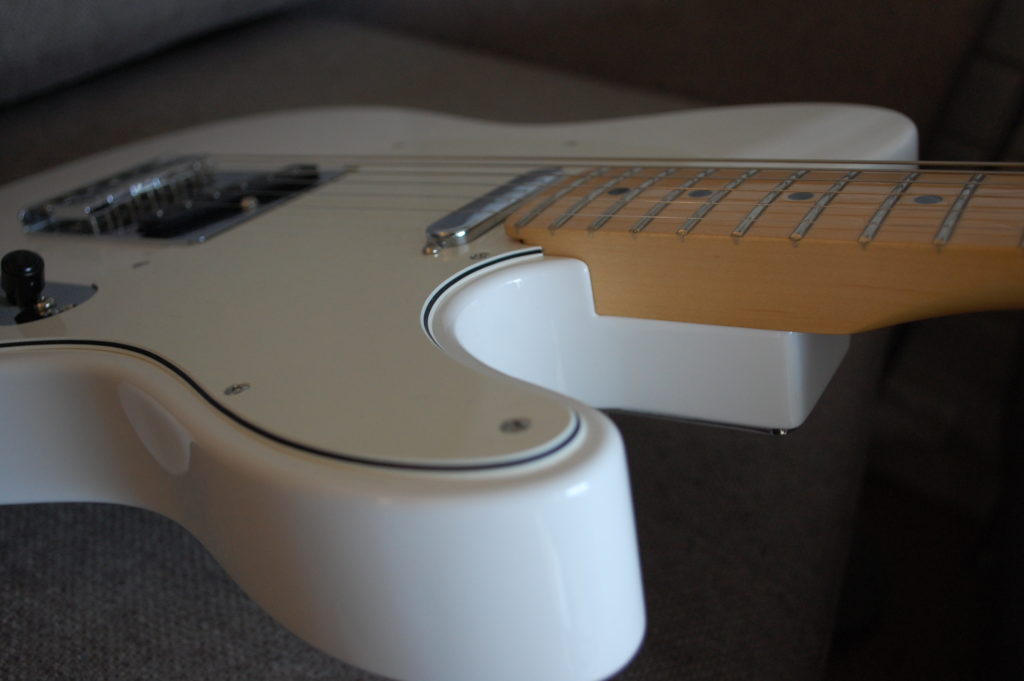
Gibson ES-335

Gibson ES-335 Dot 2001 (2021)
Two humbuckers in classic Gibson configuration, set-neck with easy access to the upper frets, laminated thinline body with centre block anchoring the strings by way of stoptail and tun-o-matic bridge. Dot markers and white binding fading to yellow.
The game-changing Gibson invention from the late fifties, based on Les Paul’s idea of having a sustain-keeping centre block – or log – with resonance-providing wings also keeping the instrument in place on the lap. Its sibling was the 330 with the same body shape and trapeze tailpiece, but no centre block and P90s replacing the ‘buckers. Younger and more appointed relatives are the 345 from February 1959 (great moment in history; got a later model from the seventies, see above) and 355 with even more decorations and golden bling. Later came the 339 which provided a smaller body.
My first centre-blocked experience was the Jay Turser. I loved it, but as I saw the possibilities of upgrading, it had to go as an ES-135 was incoming. A few years later the 345 was beckoning, and shortly after I found the opportunity and the funds to acquire the proper thing: A cherry dot 335. Expectations fulfilled. Per now I have two MIJ thinline 330 copies along with the proper semi-acoustic 335 and 345, plus an ES Artist, making up a quintet of rounded-ears models with roots in the late fifties, just like yours truly. Soundwise, this has the appealing mix of the airiness of the 175 coupled with the sustain of the Les Paul. The stoptail is also anchoring the notes in a different way than the 345, which is not saying better or worse. And being aesthetically concerned, you can’t fault a cherry red dot model.
But then, as a couple of seventies models had found their way in, I decided to put this one up for sale, mostly to see what would happen. And what happened was, I got an exchange offer I could not resist. See The Plain Cool for a surprise visit from mr. P. R. Smith.
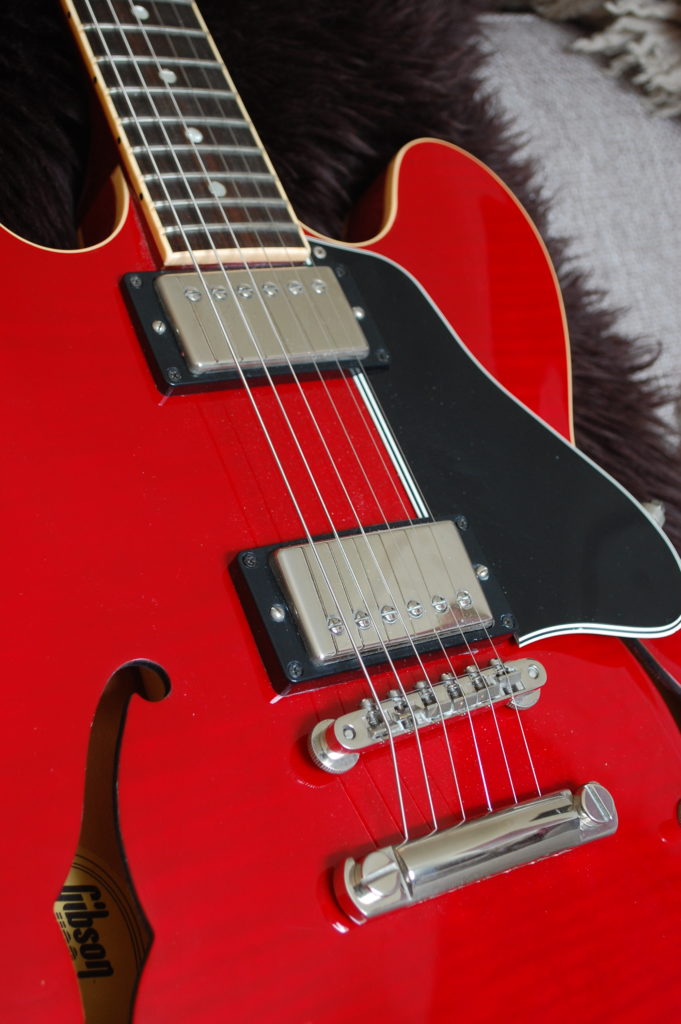
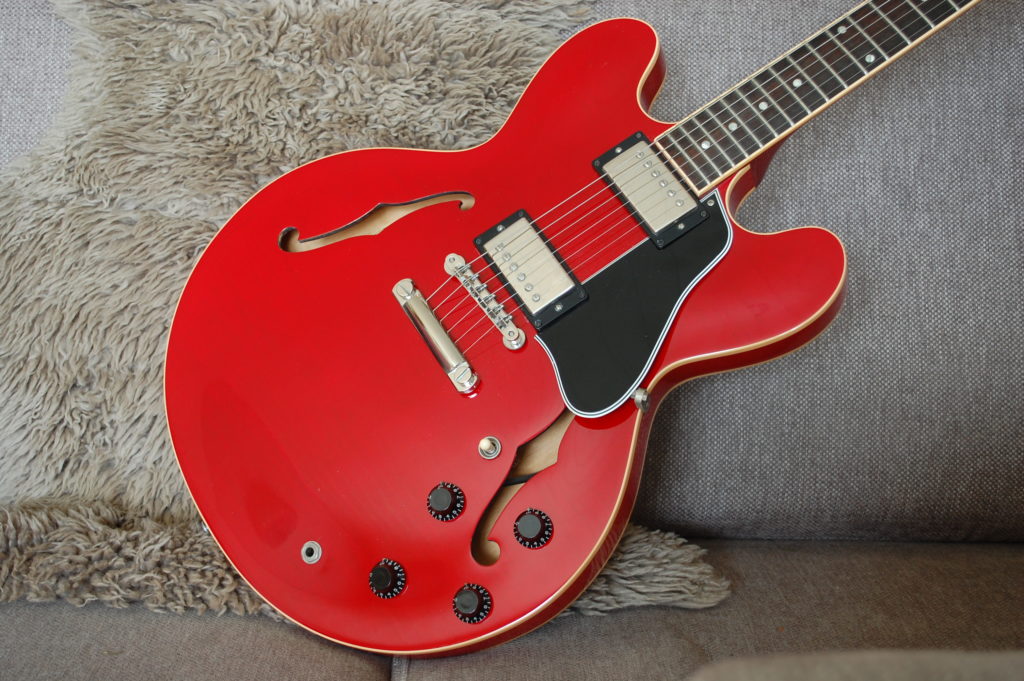
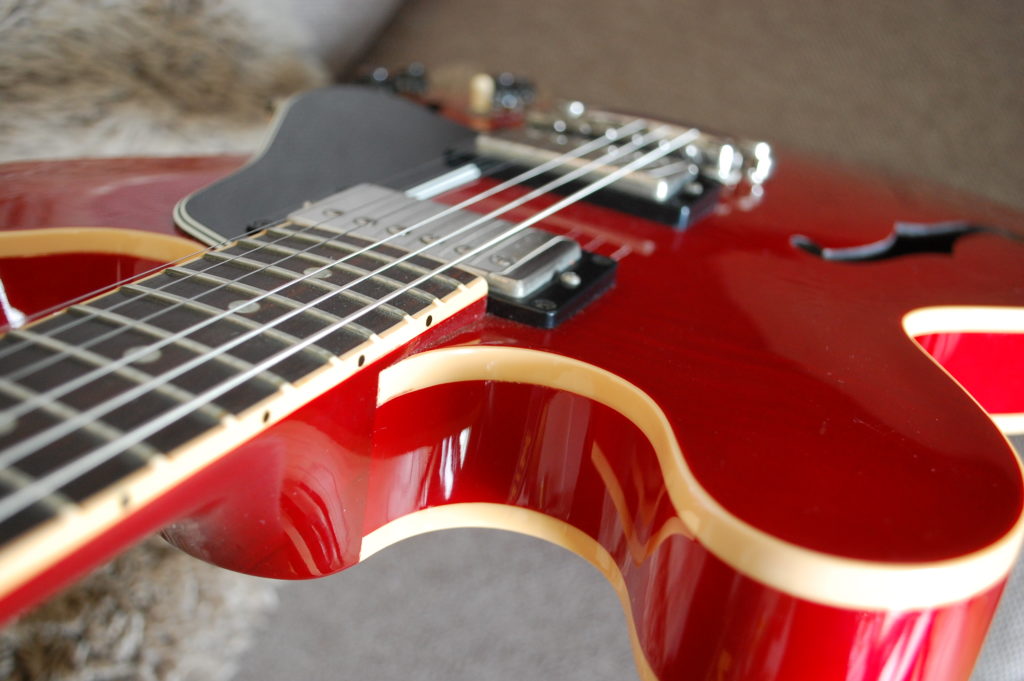
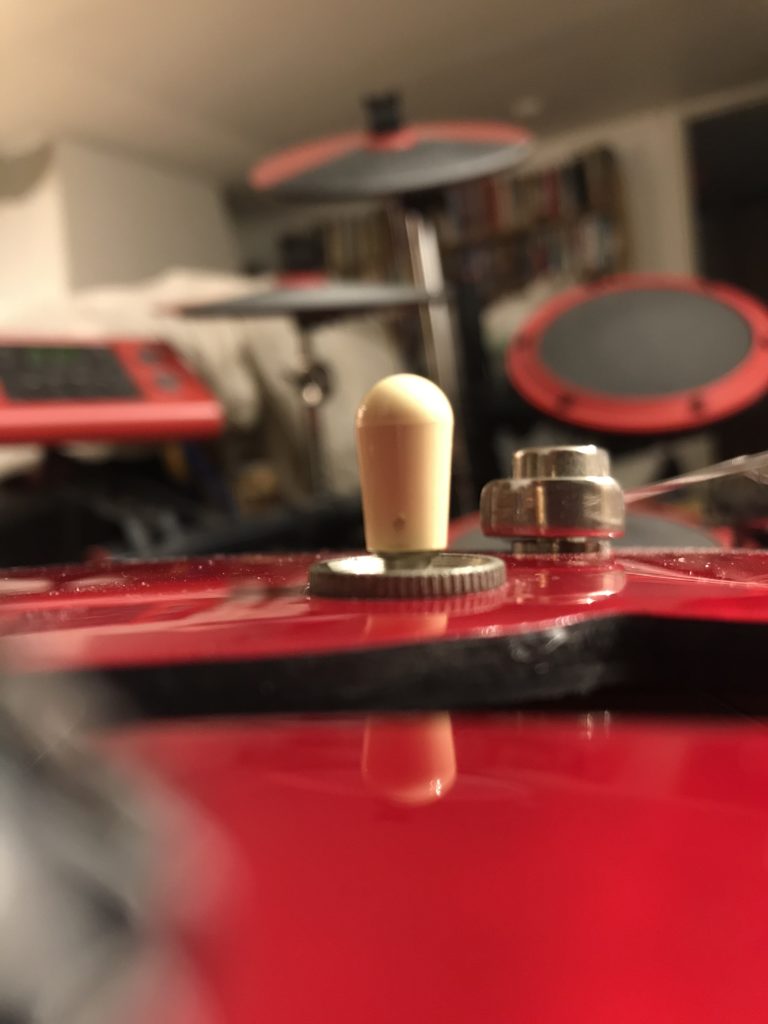
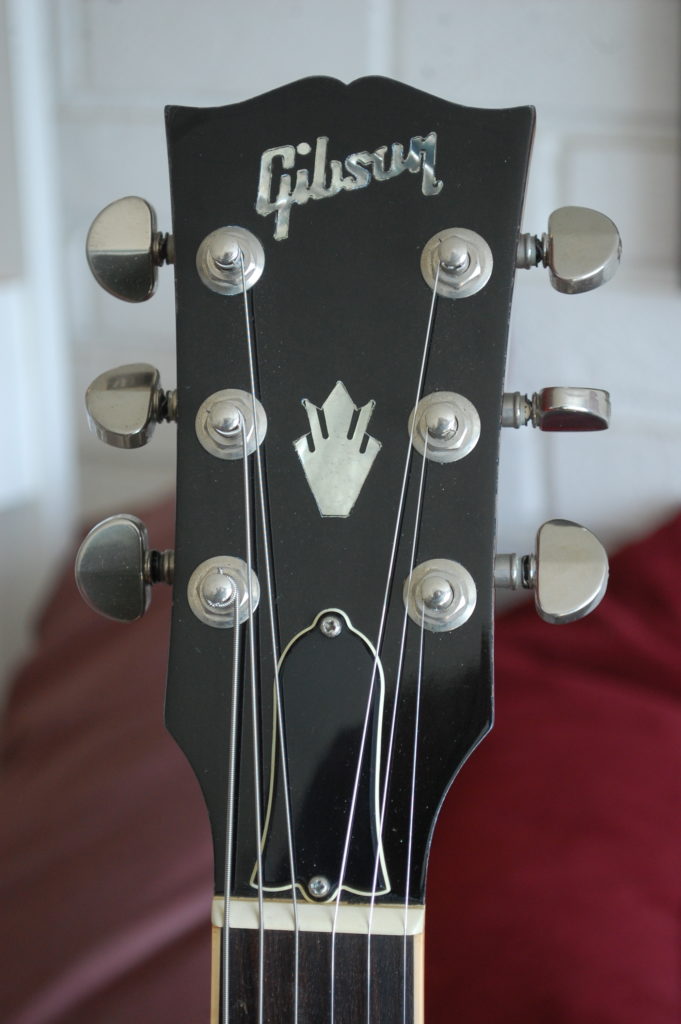
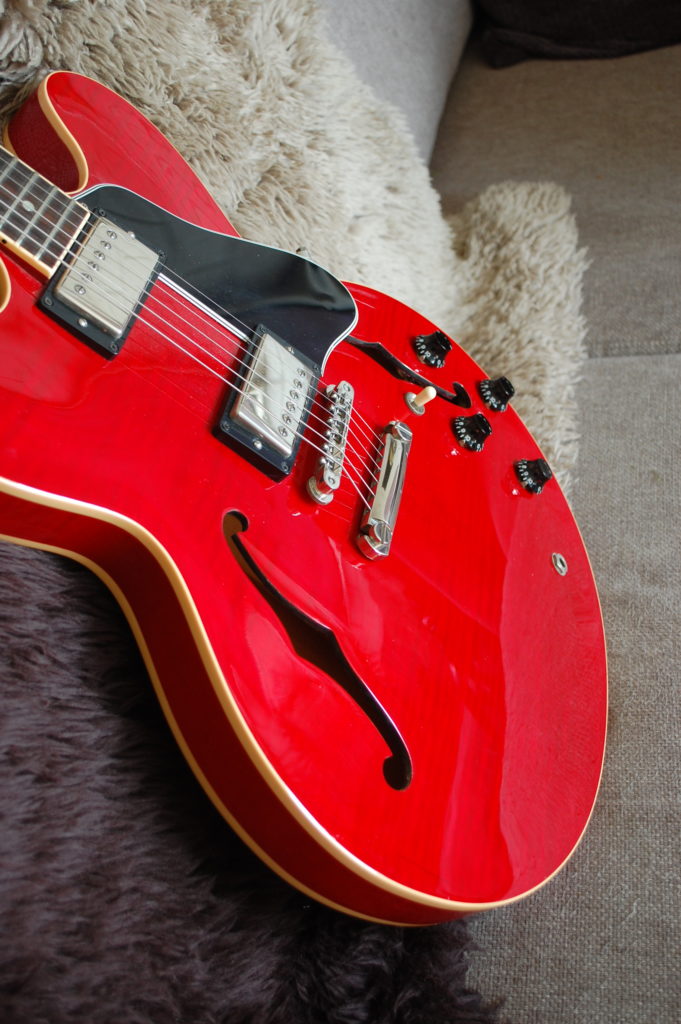
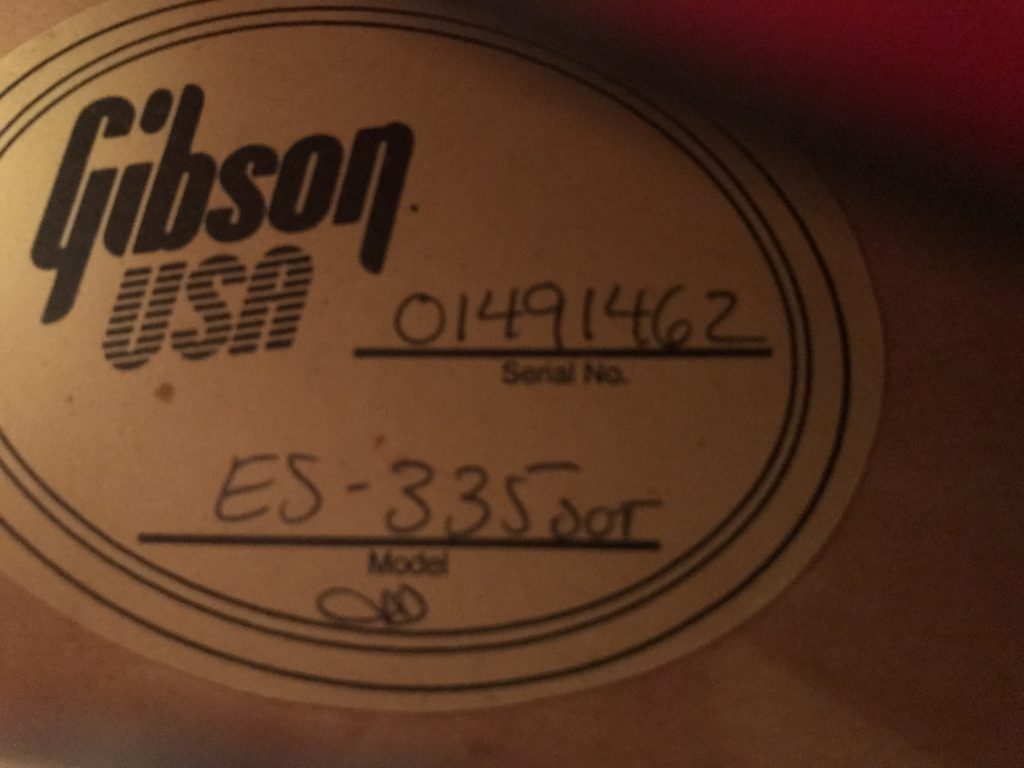
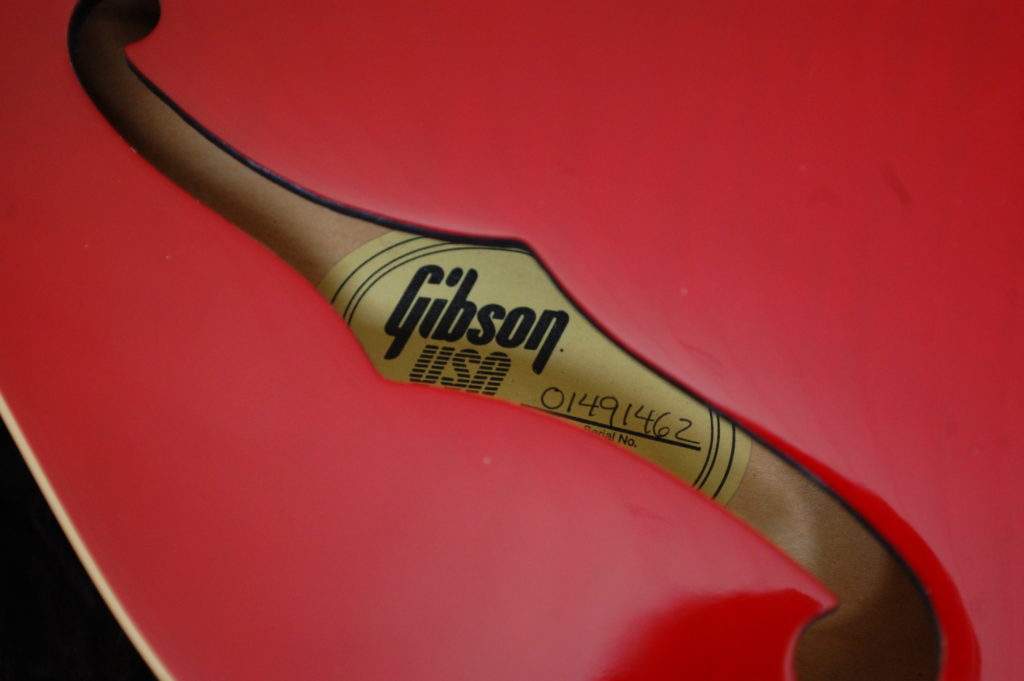
Tour
Nearing the end of this tour, please see the extras and the end credits. Step 16 is right here.